Stan C. Smith's Blog, page 28
December 29, 2019
Awesome Animal - Reindeer
There are two reasons why I chose the reindeer for this post. The first one is obvious, right? It's close to Christmas.
The second reason? Because reindeer play a role in the upcoming first book in my new series. The series is titled Across Horizons , and it is my own twist on time travel (more information on the series in future newsletters). The first book takes place 47,000 years in the past, when reindeer roamed much of the northern hemisphere in vast herds. At the time, there were also cave lions, cave bears, woolly rhinos, and countless other impressive mammals... but again, more on that later.
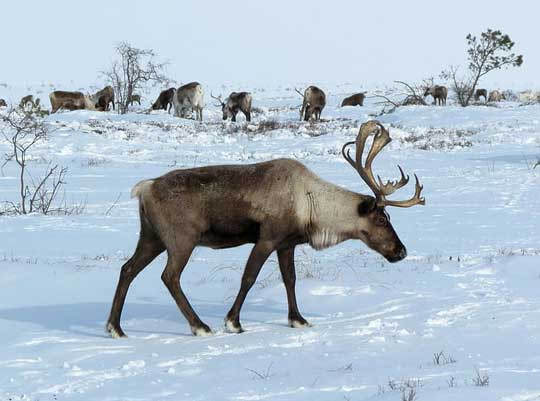
What the heck is a Reindeer?
Everyone has heard of reindeer, but does everyone know much about the actual wild animal? First, you should know that in North America these creatures are called caribou . Yep, caribou and reindeer are the same species.
As the name suggests, they are a species of deer, with the scientific name of Rangifer tarandus. They are all the same species, but there are at least 13 different subspecies, usually separated into geographically distinct "herds."
Amazing facts about Reindeer
Reindeer have what's called a circumpolar distribution. This means they exist all the way around the world at far north latitudes (near the North Pole). So, they can be found in the cold, northern regions of North America, Greenland, Europe, and Siberia.
Reindeer have impressive antlers. In fact, relative to body size, they have the largest, heaviest antlers of all the living species of deer. A male's antlers can reach up to 51 inches (130 cm) long. Moose can have larger antlers, but they also have much larger bodies.
Keep in mind that antlers and horns are not the same thing. Antlers are made of bone, they usually are branched, and they grow and fall off every year. Antlers are features of the deer family (Cervidae). Horns have a bony core covered by a keratin sheath (keratin is the protein that makes up hair, skin, and fingernails). Horns, which are a permanent part of the body and do not fall off, are features of the Bovidae family (cattle, sheep, goats, bison, and others).
Reindeer are the only species of deer in which both males and females grow antlers. Here is an interesting thought. Male reindeer start growing their antlers in March or April and then shed them by early December (before Christmas). Female reindeer start growing their antlers in May or June, and they don't shed them until they start having calves in the spring. Hmm... In every movie or picture of Santa and his sleigh, the reindeer have antlers. This means all those reindeer are FEMALE. Oh no, my head is going to explode! I've always thought Rudolph, and at least some of the others, were boys.
Well, hold on a second... The timing of antler shedding in males can sometimes be affected by other factors. For example, young males can keep their antlers longer. Also, males that are neutered may not lose their antlers until April. Do we dare imagine that Santa may have neutered his reindeer?
Anyway, reindeer antlers can be quite impressive.
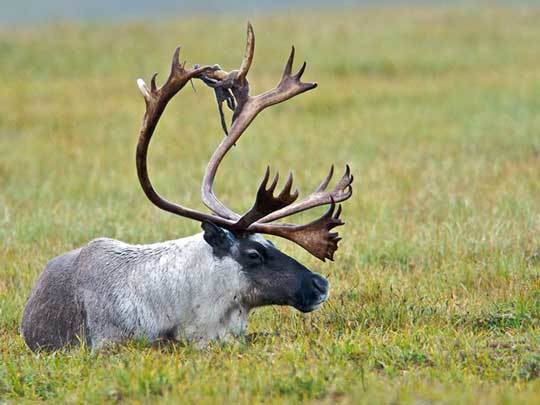
Although reindeer all belong to one species, the various subspecies can be quite different. In some subspecies, the males can grow to over 550 pounds (250 kg). The males of the smallest subspecies, the Svalbard reindeer, average only about 150 pounds (68 kg).
Hmmm... let's think about this. The very first time people were introduced to the idea of Santa having reindeer was in 1823. This was when Clement C. Moore published his poem, "A Visit from Saint Nicholas" (also known as "Twas the Night Before Christmas" from the poem's first line). In this poem, Moore described the reindeer as "tiny." That makes sense to me—we certainly don't need a 550-pound reindeer falling through the roof. So... logically, Santa's reindeer must be Svalbard reindeer. But this means that all the movies have it wrong, as they always use huge, full-sized reindeer. So confusing!
As I said, the first mention of Santa having reindeer was Moore's poem. Moore provided the names Dasher, Dancer, Prancer, Vixen, Comet, Cupid, Dunder and Blixem. Wait, what? Dunder and Blixem? Eventually, these last two were changed from Dutch to German, and they became Donner and Blitzen. But still, these two stand out. Why? Because all the others make sense in English. In German, Donner means "thunder" and Blitzen means "flash."
While I'm on a roll with Santa connections, what about Rudolph? Well, he (or she...?) wasn't introduced until 1939. That's when Robert L. May, a catalog writer for Montgomery Ward, wrote a children's book for the department store. The book was written in verse, and May titled it, “Rudolph the Red-Nosed Reindeer.” Here's what the original looked like:
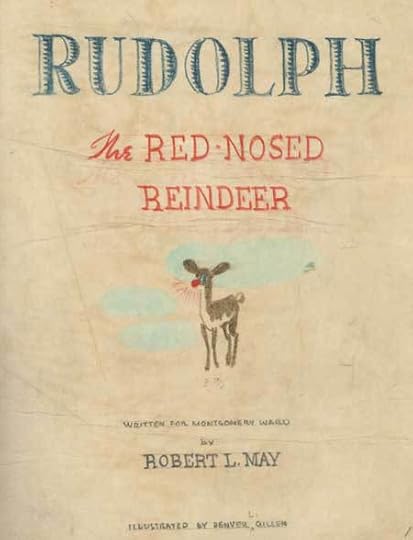
Hmm... no antlers on the original Rudolph. In fact, it didn't look much like a reindeer at all.
Okay, I have to address something I've wondered about all my life. Where did the idea come from that reindeer could fly? For my benefit and yours, I did a bit of research on this. As it turns out, this idea might be much older than you think. The anthropologist Piers Vitebsky, in his book "The Reindeer People," provides details of Reindeer Stones. These are stones that ancient people (as long ago as 3,000 years) embedded vertically in the ground. Reindeer stones are found in various places throughout the world but particularly in Siberia and Mongolia. Various animals were carved upon these stones. However, one animal was carved far more often than any other—the reindeer.
The odd thing about these carved reindeer is that they are depicted with their neck outstretched, their front legs flung out in front, and their back legs flung out behind. And often the sun is framed within the creature's antlers, as if the artists were depicting the reindeer flying through the sky.
Below is a set of "reindeer stones."

So, perhaps some ancient peoples thought of reindeer as having superpowers, including the ability to fly. The Pazyryk people were an ancient nomadic culture in the Altai mountains of Siberia. Their mummified remains are really cool because these people had a habit of covering their bodies with elaborate tattoos, and many of these tattoos are still clearly visible. Guess what was often depicted in their tattoos.... yep, flying reindeer.
Below is an actual mummified tattoo depicting a reindeer that seems to be flying. The image is shown more clearly on the right. Notice that this tattoo even shows the reindeer with a bird's beak.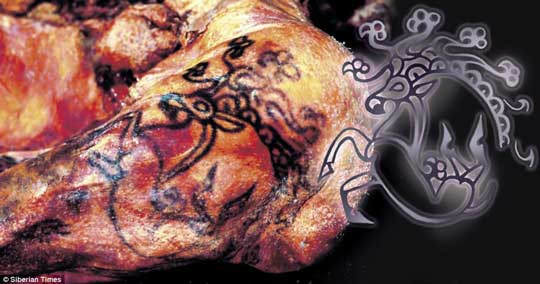
So, it seems that the idea of flying reindeer is not a new concept at all. Now, back to real reindeer...
Some reindeer subspecies migrate, others don't. Those that do migrate, though, can be pretty impressive. A few populations of reindeer in North America migrate farther than any other land animal, up to 3,100 miles each year. To accomplish this, they average about 23 miles per day. Sometimes these migrating herds can include as many as 500,000 individuals!
Check out this video of the Western Caribou Arctic Herd in Alaska.
Rivers and lakes don't slow the reindeer down as they migrate. Adults can swim long distances at 4 mph (6.4 km/hr), and they can swim 6 mph (10 km/hr) when they are in a real hurry.
Check out this video of a swimming herd.
A migrating herd of thousands of reindeer must be an amazing sight to see.

One last random fact: An entire reindeer was once found inside the stomach of a Greenland shark. I just thought you might want to know that.
So, the Reindeer deserves a place in the P.A.H.O.F.
(Primo Animal Hall of Fame).
FUN FACT: The word primo originated in the mid 1700s. In Italian it literally means first. By the late 1700s it was primarily a musical term, meaning the first or leading part in an ensemble. Much more recently, the word has been adopted to describe something as excellent or first class ("That's a primo flying reindeer tattoo you got there."). In the1990s, it was often used as street slang to describe the high quality of drugs ("This is some primo weed, man!"). So, primo is another way to say awesome!
Photo Credits:
Reindeer herd #1 - Creative Commons via pxfuel.com
Reindeer with big antlers - National Park Service
Rudolph book - Rauner Special Collections Library/Dartmouth College via NPR
Reindeer stones - Alix Guillard, Wikimedia Commons, via Earthtouchnews
Reindeer tattoo - SiberianTimes via DailyMail
Large reindeer herd - ADF&G via National Park Service
The second reason? Because reindeer play a role in the upcoming first book in my new series. The series is titled Across Horizons , and it is my own twist on time travel (more information on the series in future newsletters). The first book takes place 47,000 years in the past, when reindeer roamed much of the northern hemisphere in vast herds. At the time, there were also cave lions, cave bears, woolly rhinos, and countless other impressive mammals... but again, more on that later.

What the heck is a Reindeer?
Everyone has heard of reindeer, but does everyone know much about the actual wild animal? First, you should know that in North America these creatures are called caribou . Yep, caribou and reindeer are the same species.
As the name suggests, they are a species of deer, with the scientific name of Rangifer tarandus. They are all the same species, but there are at least 13 different subspecies, usually separated into geographically distinct "herds."
Amazing facts about Reindeer
Reindeer have what's called a circumpolar distribution. This means they exist all the way around the world at far north latitudes (near the North Pole). So, they can be found in the cold, northern regions of North America, Greenland, Europe, and Siberia.
Reindeer have impressive antlers. In fact, relative to body size, they have the largest, heaviest antlers of all the living species of deer. A male's antlers can reach up to 51 inches (130 cm) long. Moose can have larger antlers, but they also have much larger bodies.
Keep in mind that antlers and horns are not the same thing. Antlers are made of bone, they usually are branched, and they grow and fall off every year. Antlers are features of the deer family (Cervidae). Horns have a bony core covered by a keratin sheath (keratin is the protein that makes up hair, skin, and fingernails). Horns, which are a permanent part of the body and do not fall off, are features of the Bovidae family (cattle, sheep, goats, bison, and others).
Reindeer are the only species of deer in which both males and females grow antlers. Here is an interesting thought. Male reindeer start growing their antlers in March or April and then shed them by early December (before Christmas). Female reindeer start growing their antlers in May or June, and they don't shed them until they start having calves in the spring. Hmm... In every movie or picture of Santa and his sleigh, the reindeer have antlers. This means all those reindeer are FEMALE. Oh no, my head is going to explode! I've always thought Rudolph, and at least some of the others, were boys.
Well, hold on a second... The timing of antler shedding in males can sometimes be affected by other factors. For example, young males can keep their antlers longer. Also, males that are neutered may not lose their antlers until April. Do we dare imagine that Santa may have neutered his reindeer?
Anyway, reindeer antlers can be quite impressive.

Although reindeer all belong to one species, the various subspecies can be quite different. In some subspecies, the males can grow to over 550 pounds (250 kg). The males of the smallest subspecies, the Svalbard reindeer, average only about 150 pounds (68 kg).
Hmmm... let's think about this. The very first time people were introduced to the idea of Santa having reindeer was in 1823. This was when Clement C. Moore published his poem, "A Visit from Saint Nicholas" (also known as "Twas the Night Before Christmas" from the poem's first line). In this poem, Moore described the reindeer as "tiny." That makes sense to me—we certainly don't need a 550-pound reindeer falling through the roof. So... logically, Santa's reindeer must be Svalbard reindeer. But this means that all the movies have it wrong, as they always use huge, full-sized reindeer. So confusing!
As I said, the first mention of Santa having reindeer was Moore's poem. Moore provided the names Dasher, Dancer, Prancer, Vixen, Comet, Cupid, Dunder and Blixem. Wait, what? Dunder and Blixem? Eventually, these last two were changed from Dutch to German, and they became Donner and Blitzen. But still, these two stand out. Why? Because all the others make sense in English. In German, Donner means "thunder" and Blitzen means "flash."
While I'm on a roll with Santa connections, what about Rudolph? Well, he (or she...?) wasn't introduced until 1939. That's when Robert L. May, a catalog writer for Montgomery Ward, wrote a children's book for the department store. The book was written in verse, and May titled it, “Rudolph the Red-Nosed Reindeer.” Here's what the original looked like:

Hmm... no antlers on the original Rudolph. In fact, it didn't look much like a reindeer at all.
Okay, I have to address something I've wondered about all my life. Where did the idea come from that reindeer could fly? For my benefit and yours, I did a bit of research on this. As it turns out, this idea might be much older than you think. The anthropologist Piers Vitebsky, in his book "The Reindeer People," provides details of Reindeer Stones. These are stones that ancient people (as long ago as 3,000 years) embedded vertically in the ground. Reindeer stones are found in various places throughout the world but particularly in Siberia and Mongolia. Various animals were carved upon these stones. However, one animal was carved far more often than any other—the reindeer.
The odd thing about these carved reindeer is that they are depicted with their neck outstretched, their front legs flung out in front, and their back legs flung out behind. And often the sun is framed within the creature's antlers, as if the artists were depicting the reindeer flying through the sky.
Below is a set of "reindeer stones."

So, perhaps some ancient peoples thought of reindeer as having superpowers, including the ability to fly. The Pazyryk people were an ancient nomadic culture in the Altai mountains of Siberia. Their mummified remains are really cool because these people had a habit of covering their bodies with elaborate tattoos, and many of these tattoos are still clearly visible. Guess what was often depicted in their tattoos.... yep, flying reindeer.
Below is an actual mummified tattoo depicting a reindeer that seems to be flying. The image is shown more clearly on the right. Notice that this tattoo even shows the reindeer with a bird's beak.

So, it seems that the idea of flying reindeer is not a new concept at all. Now, back to real reindeer...
Some reindeer subspecies migrate, others don't. Those that do migrate, though, can be pretty impressive. A few populations of reindeer in North America migrate farther than any other land animal, up to 3,100 miles each year. To accomplish this, they average about 23 miles per day. Sometimes these migrating herds can include as many as 500,000 individuals!
Check out this video of the Western Caribou Arctic Herd in Alaska.
Rivers and lakes don't slow the reindeer down as they migrate. Adults can swim long distances at 4 mph (6.4 km/hr), and they can swim 6 mph (10 km/hr) when they are in a real hurry.
Check out this video of a swimming herd.
A migrating herd of thousands of reindeer must be an amazing sight to see.

One last random fact: An entire reindeer was once found inside the stomach of a Greenland shark. I just thought you might want to know that.
So, the Reindeer deserves a place in the P.A.H.O.F.
(Primo Animal Hall of Fame).
FUN FACT: The word primo originated in the mid 1700s. In Italian it literally means first. By the late 1700s it was primarily a musical term, meaning the first or leading part in an ensemble. Much more recently, the word has been adopted to describe something as excellent or first class ("That's a primo flying reindeer tattoo you got there."). In the1990s, it was often used as street slang to describe the high quality of drugs ("This is some primo weed, man!"). So, primo is another way to say awesome!
Photo Credits:
Reindeer herd #1 - Creative Commons via pxfuel.com
Reindeer with big antlers - National Park Service
Rudolph book - Rauner Special Collections Library/Dartmouth College via NPR
Reindeer stones - Alix Guillard, Wikimedia Commons, via Earthtouchnews
Reindeer tattoo - SiberianTimes via DailyMail
Large reindeer herd - ADF&G via National Park Service
Published on December 29, 2019 10:09
December 13, 2019
Awesome Animal - Chinese Giant Salamander
I can't help it. I have to feature another amphibian (in my last post I featured the Caecilian). After all,
Bridgers 6
is filled with awesome amphibians, so these critters are on my mind lately.
Bridgers 6 takes place on an alternate version of Earth teeming with creatures descended from amphibians. There are big ones, small ones, scary ones, and tall ones!
What's the biggest amphibian on our own version of Earth, you ask? Without a doubt, it's the Chinese giant salamander.
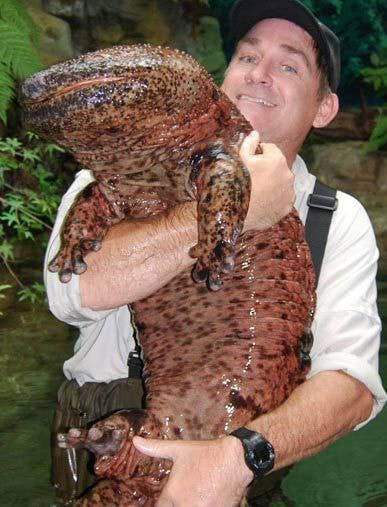
What the heck is a Chinese giant salamander?
Hiding in rocky streams in the Yangtze river basin of central China is an amazing salamander that grows to six feet (1.8 meters) long and weighs up to 110 pounds (50 kg). They are known to live at least sixty years, and possibly much longer. For a long time, scientists thought there was only one species, but genetic analysis indicates there are probably three or more distinct species.
Giant salamanders belong to the family Cryptobranchidae. There is actually one other member of this family, the hellbender (also known as the snot otter), which grows to two feet long and lives in the eastern United States (I featured the hellbender back in May).
Amazing facts about Chinese giant salamanders
Giant salamanders are considered living fossils because the Cryptobranchidae family has been around for 170 million years. Much of their history was during the time of dinosaurs! They have changed very little during all that time.
Giant salamanders spend their entire lives under water. Surprisingly, though, they do not have gills. Heck, they don't even have lungs. They get their oxygen by absorbing it directly through their skin. So, as you would expect, they need to live in streams with fast-moving, highly-oxygenated water. See all those folds of skin on the creature's sides? Those folds increase the surface area of the skin, which in turn increases the amount of oxygen absorbed.

Giant salamanders are predators, and they eat almost anything that moves and will fit in their mouth. They will suck up aquatic insects, worms, frogs, other salamanders, freshwater crabs, shrimp, and fish. They even eat smaller individuals of their own species, In fact, one study found that 28% of all the food found in the bellies of 79 giant salamanders was other giant salamanders.
Above I mentioned that they suck up their prey. This is called the gape-and-suck method, and it's actually a highly effective way to feed (many fish do this too). Here's how it works. When they sense prey in front of them, they greatly increase the size of their throat and pop open their mouth. This creates a powerful sucking action and draws in water, as well as any unfortunate creature swimming in the water. To make this even more effective, they displace their jaw in the process. This entire motion takes place in just a fraction of a second.
Check out this slow-motion video of how powerful this prey-sucking methods works!
I also mentioned above that giant salamanders "sense" the prey in front of them. They have very poor eyesight. Instead of seeing their prey, they have rows of special sensory nodes along each side of their body, from their head all the way to their tail. These sensory nodes allow them to detect the tiniest of vibrations in the water. So they "see" by detecting the vibrations other creatures create. This must work pretty well, because they catch enough prey to grow to over a hundred pounds!
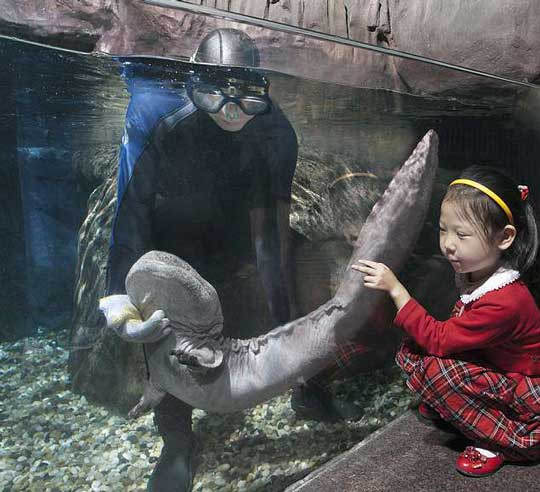
Sure, the Chinese giant salamander is a big amphibian, but is it the biggest amphibian ever? Not even close. About 275 million years ago, in the swamps and rivers of an area that is now Brazil, lived the Prionosuchus. Amazingly, Prionosuchus grew at least 30 feet long and weighed 4,400 pounds (2,000 kg).
Prionosuchus was the amphibian version of a crocodile (does this sound familiar to those of you who have read Bridgers 6 ?), or more accurately, a gharial, a fish-eating crocodile with a long, narrow, toothy snout. The diagram below gives you an ideas of the size of the Prionosuchus. Keep in mind this creature was an amphibian!

There is an interesting story behind the first identification of giant salamanders. Surprisingly, scientists knew about giant salamanders from fossils before discovering living specimens. In 1726, Johann Scheuchze described a fossil giant salamander from Switzerland. He mistakingly believed the fossil was of a human that had drowned in the biblical flood, the Deluge. So he gave the fossil the name Homo diluvii testis. In Latin, this means Man, a witness of the Deluge.
The fossil (shown below) was about three feet (1 m) long, and the tail and hind legs were missing, so Scheuchze assumed it was a human child that had been violently trampled, perhaps in an attempt to escape the Deluge.

In 1758, another scientist decided the fossil was a catfish. Then in 1787, another scientist decided it was a lizard. In 1809, yet another scientist concluded that it was "nothing but a salamander, or rather a proteus of gigantic dimensions and of an unknown species."
Hmm... biology has come a long way in the last 250 years, hasn't it? Interestingly, in 1837, when the giant salamander was given its genus name (the name still used today), it was named Andrias. This means image of man. And scheuchzeri was assigned as the species name. These two names together honor Johann Scheuchze and his (mistaken) beliefs.
By the way (I can't help mentioning this), the species Andrias scheuchzeri was used by the Czech author Karel Čapek in his 1931 science fiction novel, War with the Newts (also translated as War with the Salamanders). In the Pacific, a race of intelligent salamanders are found. They are enslaved and abused. But then they rebel, which leads to a global war for species domination. This satirical book is considered by many to be the first ever dystopian sci-fi novel, and many consider it to be the best science fiction book ever written.

Chinese giant salamanders have inspired numerous myths and legends in Chinese culture. In fact, the commonly-seen yin and yang symbol is thought to have originally been two giant salamanders intertwined harmoniously. Also, these salamanders are often called wa wa yu, which means baby fish. Why? Because the giant salamander's distress call sounds like a human baby crying.
Check out this brief video about the Chinese giant salamander.
Okay, one more thing about the Chinese giant salamander. These creatures were once common in the rivers across southeast China. Unfortunately, now they are critically endangered in the wild. They have become a fashionable delicacy among the wealthy, and this has resulted in almost complete decimation in the wild from poaching.
Today most giant salamanders are found on commercial farms that raise them for food, sometimes bringing $1,500 per salamander. The Chinese government encourages the farms to release some of their salamanders into the wild. At first, this seems like a good idea. BUT... scientists have found that the farm-raised salamanders are genetically different from those in the wild. It seems the wild salamanders can easily be divided into five very different genetic groups, and the groups split apart from each other millions of years ago. But the farm salamanders are a result of extensive genetic mixing. So, the original genetically-distinct types in the wild are quickly being replaced by these new, artificially-mixed salamanders that never existed before. Hmm... an interesting dilemma.
So, the Chinese Giant Salamander deserves a place in the B.A.H.O.F.
(Boffo Animal Hall of Fame).
FUN FACT: The word boffo was first recorded in use in the 1940s. Basically it means sensational or extremely successful. By the 1960s, the word was commonly used in show business. This usage is thought to have originated in the Hollywood trade magazine Variety. Example: "It was a boffo performance, impressing even the harshest critics." So, basically, boffo means it's a hit. In spite of the giant salamander's recent troubles (being endangered), the fact that the creature has been around for 170 million years indicates a boffo performance (evolutionarily speaking). So, boffo is another way to say awesome!
Photo Credits:
Indian pipe - Stan C. Smith
Man holding giant salamander - Pinterest
Giant salamander in river - San Diego Zoo
Girl with salamander in zoo - Getty Images via DailyMail
Giant salamander fossil - Wikimedia
Bridgers 6 takes place on an alternate version of Earth teeming with creatures descended from amphibians. There are big ones, small ones, scary ones, and tall ones!
What's the biggest amphibian on our own version of Earth, you ask? Without a doubt, it's the Chinese giant salamander.

What the heck is a Chinese giant salamander?
Hiding in rocky streams in the Yangtze river basin of central China is an amazing salamander that grows to six feet (1.8 meters) long and weighs up to 110 pounds (50 kg). They are known to live at least sixty years, and possibly much longer. For a long time, scientists thought there was only one species, but genetic analysis indicates there are probably three or more distinct species.
Giant salamanders belong to the family Cryptobranchidae. There is actually one other member of this family, the hellbender (also known as the snot otter), which grows to two feet long and lives in the eastern United States (I featured the hellbender back in May).
Amazing facts about Chinese giant salamanders
Giant salamanders are considered living fossils because the Cryptobranchidae family has been around for 170 million years. Much of their history was during the time of dinosaurs! They have changed very little during all that time.
Giant salamanders spend their entire lives under water. Surprisingly, though, they do not have gills. Heck, they don't even have lungs. They get their oxygen by absorbing it directly through their skin. So, as you would expect, they need to live in streams with fast-moving, highly-oxygenated water. See all those folds of skin on the creature's sides? Those folds increase the surface area of the skin, which in turn increases the amount of oxygen absorbed.

Giant salamanders are predators, and they eat almost anything that moves and will fit in their mouth. They will suck up aquatic insects, worms, frogs, other salamanders, freshwater crabs, shrimp, and fish. They even eat smaller individuals of their own species, In fact, one study found that 28% of all the food found in the bellies of 79 giant salamanders was other giant salamanders.
Above I mentioned that they suck up their prey. This is called the gape-and-suck method, and it's actually a highly effective way to feed (many fish do this too). Here's how it works. When they sense prey in front of them, they greatly increase the size of their throat and pop open their mouth. This creates a powerful sucking action and draws in water, as well as any unfortunate creature swimming in the water. To make this even more effective, they displace their jaw in the process. This entire motion takes place in just a fraction of a second.
Check out this slow-motion video of how powerful this prey-sucking methods works!
I also mentioned above that giant salamanders "sense" the prey in front of them. They have very poor eyesight. Instead of seeing their prey, they have rows of special sensory nodes along each side of their body, from their head all the way to their tail. These sensory nodes allow them to detect the tiniest of vibrations in the water. So they "see" by detecting the vibrations other creatures create. This must work pretty well, because they catch enough prey to grow to over a hundred pounds!

Sure, the Chinese giant salamander is a big amphibian, but is it the biggest amphibian ever? Not even close. About 275 million years ago, in the swamps and rivers of an area that is now Brazil, lived the Prionosuchus. Amazingly, Prionosuchus grew at least 30 feet long and weighed 4,400 pounds (2,000 kg).
Prionosuchus was the amphibian version of a crocodile (does this sound familiar to those of you who have read Bridgers 6 ?), or more accurately, a gharial, a fish-eating crocodile with a long, narrow, toothy snout. The diagram below gives you an ideas of the size of the Prionosuchus. Keep in mind this creature was an amphibian!

There is an interesting story behind the first identification of giant salamanders. Surprisingly, scientists knew about giant salamanders from fossils before discovering living specimens. In 1726, Johann Scheuchze described a fossil giant salamander from Switzerland. He mistakingly believed the fossil was of a human that had drowned in the biblical flood, the Deluge. So he gave the fossil the name Homo diluvii testis. In Latin, this means Man, a witness of the Deluge.
The fossil (shown below) was about three feet (1 m) long, and the tail and hind legs were missing, so Scheuchze assumed it was a human child that had been violently trampled, perhaps in an attempt to escape the Deluge.

In 1758, another scientist decided the fossil was a catfish. Then in 1787, another scientist decided it was a lizard. In 1809, yet another scientist concluded that it was "nothing but a salamander, or rather a proteus of gigantic dimensions and of an unknown species."
Hmm... biology has come a long way in the last 250 years, hasn't it? Interestingly, in 1837, when the giant salamander was given its genus name (the name still used today), it was named Andrias. This means image of man. And scheuchzeri was assigned as the species name. These two names together honor Johann Scheuchze and his (mistaken) beliefs.
By the way (I can't help mentioning this), the species Andrias scheuchzeri was used by the Czech author Karel Čapek in his 1931 science fiction novel, War with the Newts (also translated as War with the Salamanders). In the Pacific, a race of intelligent salamanders are found. They are enslaved and abused. But then they rebel, which leads to a global war for species domination. This satirical book is considered by many to be the first ever dystopian sci-fi novel, and many consider it to be the best science fiction book ever written.

Chinese giant salamanders have inspired numerous myths and legends in Chinese culture. In fact, the commonly-seen yin and yang symbol is thought to have originally been two giant salamanders intertwined harmoniously. Also, these salamanders are often called wa wa yu, which means baby fish. Why? Because the giant salamander's distress call sounds like a human baby crying.
Check out this brief video about the Chinese giant salamander.
Okay, one more thing about the Chinese giant salamander. These creatures were once common in the rivers across southeast China. Unfortunately, now they are critically endangered in the wild. They have become a fashionable delicacy among the wealthy, and this has resulted in almost complete decimation in the wild from poaching.
Today most giant salamanders are found on commercial farms that raise them for food, sometimes bringing $1,500 per salamander. The Chinese government encourages the farms to release some of their salamanders into the wild. At first, this seems like a good idea. BUT... scientists have found that the farm-raised salamanders are genetically different from those in the wild. It seems the wild salamanders can easily be divided into five very different genetic groups, and the groups split apart from each other millions of years ago. But the farm salamanders are a result of extensive genetic mixing. So, the original genetically-distinct types in the wild are quickly being replaced by these new, artificially-mixed salamanders that never existed before. Hmm... an interesting dilemma.
So, the Chinese Giant Salamander deserves a place in the B.A.H.O.F.
(Boffo Animal Hall of Fame).
FUN FACT: The word boffo was first recorded in use in the 1940s. Basically it means sensational or extremely successful. By the 1960s, the word was commonly used in show business. This usage is thought to have originated in the Hollywood trade magazine Variety. Example: "It was a boffo performance, impressing even the harshest critics." So, basically, boffo means it's a hit. In spite of the giant salamander's recent troubles (being endangered), the fact that the creature has been around for 170 million years indicates a boffo performance (evolutionarily speaking). So, boffo is another way to say awesome!
Photo Credits:
Indian pipe - Stan C. Smith
Man holding giant salamander - Pinterest
Giant salamander in river - San Diego Zoo
Girl with salamander in zoo - Getty Images via DailyMail
Giant salamander fossil - Wikimedia
Published on December 13, 2019 07:21
December 3, 2019
Awesome Animal - Caecilian
Recently, I spotted this frog clinging to the corner of one of our little bird houses.
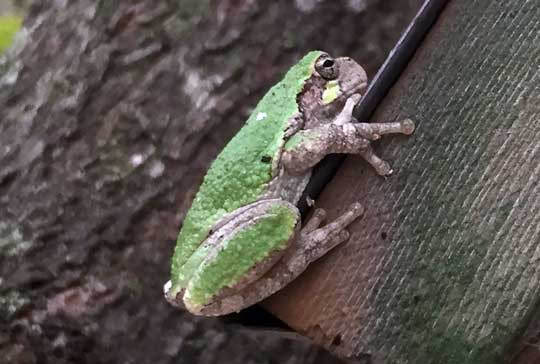
In spite of its mostly green color, this is a gray treefrog. These frogs can change their color, and they are actually gray more often than they are green. But when they are surrounded by green vegetation, their skin turns green like the one in this photo. You know, like a chameleon.
Let's think about this for a moment... their skin changes color to better conceal them. Wow. Perhaps amphibians are under-appreciated for their awesomeness. Consider the Olm, a blind salamander with transparent skin that lives underground, hunts for its prey by smell and electrosensitivity, and can survive without food for 10 years (seriously). Then there's the Chinese giant salamander that can grow up to 1.8 meters in length and evolved independently from all other amphibians over one hundred million years before Tyrannosaurus rex. And there's the Chile Darwin’s frog—the fathers protect the young in their mouths. And the Gardiner’s Seychelles frog, the world’s smallest frog, with adults growing up to be the size of a pencil eraser. And let's not forget about the caecilian, a legless amphibian that... oh, wait... the caecilian is today's Awesome Animal. Let's take a more careful look.
Have you ever heard of a glass lizard? It looks like a snake, but it's actually a lizard without legs. Well, the caecilian is kind of the glass lizard of the amphibian world—an amphibian with no legs. Actually, at first glance a caecilian looks like an earthworm. Check it out:
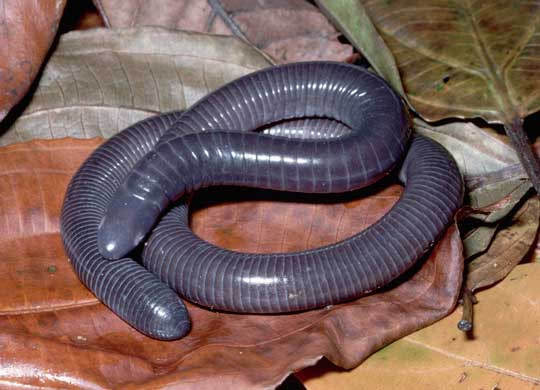
What the heck is a Caecilian?
First, Caecilian is pronounced seh-SILL-yun (almost like the pizza). Second, caecilians are amphibians, but they aren't frogs, they aren't toads, and they aren't salamanders. So what are they? They're caecilians, of course! Caecilians are their own order within the class Amphibia. In case you care, the order is called Gymnophiona (some scientists prefer to call the order Apoda, which means 'without feet').
Caecilians live on just about every continent that has moist tropical regions, including Southeast Asia, India, East and West Africa, Indonesia, and Central and South America.
Caecilians are the least known of the amphibians. One reason for this is that most of them spend their time underground (that's why they look like earthworms). Some of them are so secretive that it's almost certain that there are species we have not yet discovered. We now know of about 200 species. In fact, to celebrate the discovery of the 200th species, the musical group called the Wiggly Tendrils (this is a real band!) recorded a song titled Caecilian Cotillion.
Check out the Caecilian song!
Amazing facts about Caecilians
Where to even begin! Get ready to be amazed, because Caecilians are bizarre creatures.
Not all caecilians look like gray earthworms. They are kind of like gummy worms—they come in all colors and sizes. Check out this blue species:
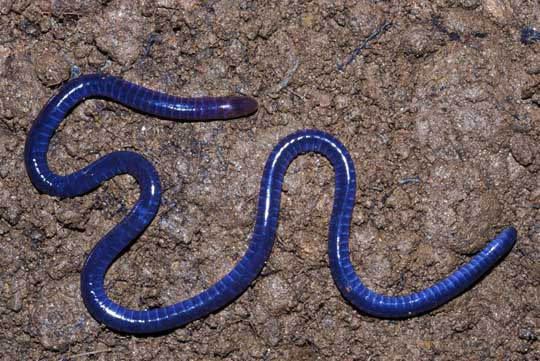
And not all of them live in the soil. Some of them are perfectly at home in the water. Check out this aquatic caecilian: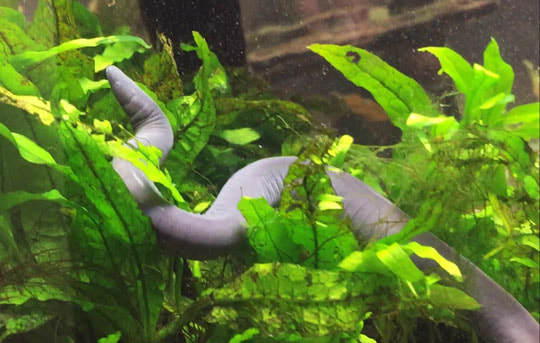
The smallest species of caecilians are only a few inches long, but the largest (Caecilia thompsoni from Colombia) can grow to five feet (1.5 m) long and weigh 2.2 pounds (1 kg). Five feet long!? What would a five-foot caecilian look like? You would think it would be fat and heavy-looking, but not so much: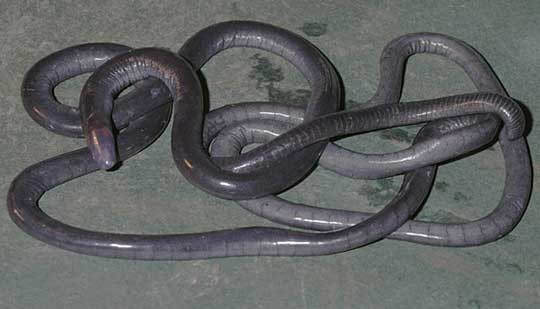
When it comes to reproduction, frogs and toads have what's called external fertilization. That means the female lays eggs, and then the male fertilizes the eggs outside of the female's body. But caecilians have internal insemination. The males have a long, tube-like organ called a phallodeum, which is inserted into the female's cloaca for about three hours (I guess they aren't in any hurry). As you can probably guess, sperm cells are transmitted into the female's body through the phallodeum, where they fertilize the eggs.
Some caecilians lay eggs, some have live birth, but I feel compelled to nominate female caecilians for Mother of the Year. I'll explain why. In some caecilian species, the mother seals herself in a subterranean cavity, where she lays her eggs. The eggs hatch, and the mother and babies remain in the cavity for four to six weeks as the babies grow. What do the babies eat, you ask? Here's where it gets weird. After the female lays eggs, her skin begins to thicken, and the skin cells fill up with fats and other nutrients. The newly-hatched babies have special teeth that are like scrapers, and they literally eat the skin off the mother. The mother grows more skin, and the babies eat that skin, too. This continues until the babies are ready to leave home and go out on their own.
So the mothers literally feed the babies their own skin, over and over. Even more bizarre, in some of the species that have live birth, the babies inside the mother's body use their special teeth to munch on their mom's reproductive organs!
Like I said, Mother of the Year.
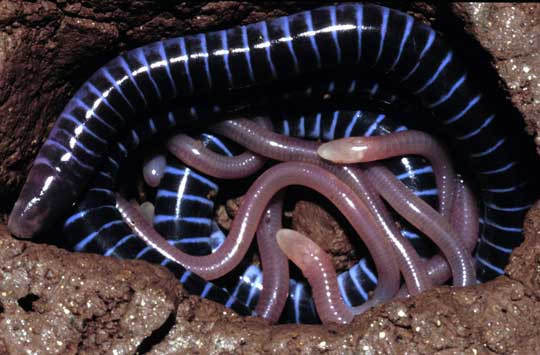
Caecilians have teeny tiny little eyes that don't see much, or don't see at all. These eyes are usually subcutaneous (buried under the skin), and some species even have bone over their eyes! There's not much need for eyes when most of your life is spent in the dark.
Not much is known about what Caecilians eat in the wild, but in captivity they readily chomp on earthworms, so worms are probably a normal part of their diet. In a study of the gut contents of 14 dead caecilians, the only identifiable objects were termite heads. That doesn't mean caecilians go around biting off the heads of termites, it just means that the heads are the portion that is most difficult to digest.
Although caecilians look like they are all tail, they actually don't even have tails. Their cloaca (that's the polite word for their butthole) is at the very end of their body.
Most caecilians breathe with lungs, but scientists were amazed to find some species without any lungs at all. Wow... eyes, legs, tails, and now lungs—caecilians seem to be all about giving things up. Apparently these lungless species can get all the oxygen they need by absorbing it directly through their skin. Here's a lungless caecilian found in Brazil:
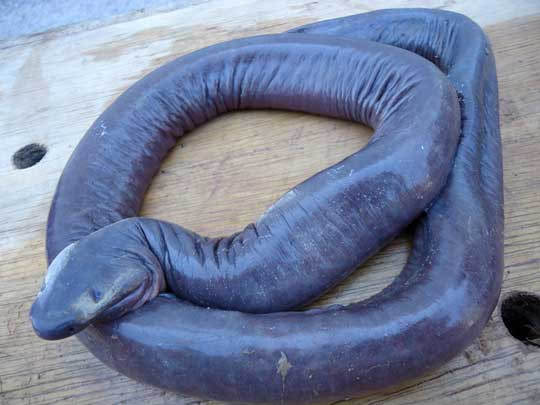
Caecilians have super-strength. They need to be strong to push their way through the soil. Scientists at the University of Chicago wanted to find out how hard caecilians could push against soil. They set up an artificial tunnel and filled one end with dirt and put a brick at that end to stop the caecilians from burrowing any farther. To measure how hard the caecilian could push, they attached a device called a force plate. The results were a surprise. They used a caecilian only 1.5 feet (50 cm) long. “It just shoved this brick off the table,” one of the scientists recalled.
Because of this amazing soil-pushing strength, caecilians have developed extra-thick, reinforced skulls to prevent serious head damage.
So, the Caecilian deserves a place in the F.S.A.H.O.F.
(Four-Star Animal Hall of Fame).
FUN FACT: The phrase four-star was first recorded in use in the early 1920s. Basically it means of a superior degree of excellence. The phrase started as the number of asterisks used to denote relative excellence in guidebooks (for example, a four-star restaurant, or a four-star hotel). It also indicates being a full general or admiral, as indicated by four stars on an insignia. As with many other such words, four-star eventually was used to describe just about anything of high quality (the caecilian is a four-star amphibian). So, four-star is another way to say awesome!
Photo Credits:
Caecilian #1 - Michael & Patricia Fogden/CORBIS via WIRED
Blue Caecilian - Unknown, via beetleboybioblog
Aquatic caecilian - National Zoo
Longest caecilian - Reptilis.org
Blue and black caecilian with babies - Alex Kupfer via Science News for Students
Lungless caecilian - B.S.F. Silva via Science News for Students

In spite of its mostly green color, this is a gray treefrog. These frogs can change their color, and they are actually gray more often than they are green. But when they are surrounded by green vegetation, their skin turns green like the one in this photo. You know, like a chameleon.
Let's think about this for a moment... their skin changes color to better conceal them. Wow. Perhaps amphibians are under-appreciated for their awesomeness. Consider the Olm, a blind salamander with transparent skin that lives underground, hunts for its prey by smell and electrosensitivity, and can survive without food for 10 years (seriously). Then there's the Chinese giant salamander that can grow up to 1.8 meters in length and evolved independently from all other amphibians over one hundred million years before Tyrannosaurus rex. And there's the Chile Darwin’s frog—the fathers protect the young in their mouths. And the Gardiner’s Seychelles frog, the world’s smallest frog, with adults growing up to be the size of a pencil eraser. And let's not forget about the caecilian, a legless amphibian that... oh, wait... the caecilian is today's Awesome Animal. Let's take a more careful look.
Have you ever heard of a glass lizard? It looks like a snake, but it's actually a lizard without legs. Well, the caecilian is kind of the glass lizard of the amphibian world—an amphibian with no legs. Actually, at first glance a caecilian looks like an earthworm. Check it out:

What the heck is a Caecilian?
First, Caecilian is pronounced seh-SILL-yun (almost like the pizza). Second, caecilians are amphibians, but they aren't frogs, they aren't toads, and they aren't salamanders. So what are they? They're caecilians, of course! Caecilians are their own order within the class Amphibia. In case you care, the order is called Gymnophiona (some scientists prefer to call the order Apoda, which means 'without feet').
Caecilians live on just about every continent that has moist tropical regions, including Southeast Asia, India, East and West Africa, Indonesia, and Central and South America.
Caecilians are the least known of the amphibians. One reason for this is that most of them spend their time underground (that's why they look like earthworms). Some of them are so secretive that it's almost certain that there are species we have not yet discovered. We now know of about 200 species. In fact, to celebrate the discovery of the 200th species, the musical group called the Wiggly Tendrils (this is a real band!) recorded a song titled Caecilian Cotillion.
Check out the Caecilian song!
Amazing facts about Caecilians
Where to even begin! Get ready to be amazed, because Caecilians are bizarre creatures.
Not all caecilians look like gray earthworms. They are kind of like gummy worms—they come in all colors and sizes. Check out this blue species:

And not all of them live in the soil. Some of them are perfectly at home in the water. Check out this aquatic caecilian:

The smallest species of caecilians are only a few inches long, but the largest (Caecilia thompsoni from Colombia) can grow to five feet (1.5 m) long and weigh 2.2 pounds (1 kg). Five feet long!? What would a five-foot caecilian look like? You would think it would be fat and heavy-looking, but not so much:

When it comes to reproduction, frogs and toads have what's called external fertilization. That means the female lays eggs, and then the male fertilizes the eggs outside of the female's body. But caecilians have internal insemination. The males have a long, tube-like organ called a phallodeum, which is inserted into the female's cloaca for about three hours (I guess they aren't in any hurry). As you can probably guess, sperm cells are transmitted into the female's body through the phallodeum, where they fertilize the eggs.
Some caecilians lay eggs, some have live birth, but I feel compelled to nominate female caecilians for Mother of the Year. I'll explain why. In some caecilian species, the mother seals herself in a subterranean cavity, where she lays her eggs. The eggs hatch, and the mother and babies remain in the cavity for four to six weeks as the babies grow. What do the babies eat, you ask? Here's where it gets weird. After the female lays eggs, her skin begins to thicken, and the skin cells fill up with fats and other nutrients. The newly-hatched babies have special teeth that are like scrapers, and they literally eat the skin off the mother. The mother grows more skin, and the babies eat that skin, too. This continues until the babies are ready to leave home and go out on their own.
So the mothers literally feed the babies their own skin, over and over. Even more bizarre, in some of the species that have live birth, the babies inside the mother's body use their special teeth to munch on their mom's reproductive organs!
Like I said, Mother of the Year.

Caecilians have teeny tiny little eyes that don't see much, or don't see at all. These eyes are usually subcutaneous (buried under the skin), and some species even have bone over their eyes! There's not much need for eyes when most of your life is spent in the dark.
Not much is known about what Caecilians eat in the wild, but in captivity they readily chomp on earthworms, so worms are probably a normal part of their diet. In a study of the gut contents of 14 dead caecilians, the only identifiable objects were termite heads. That doesn't mean caecilians go around biting off the heads of termites, it just means that the heads are the portion that is most difficult to digest.
Although caecilians look like they are all tail, they actually don't even have tails. Their cloaca (that's the polite word for their butthole) is at the very end of their body.
Most caecilians breathe with lungs, but scientists were amazed to find some species without any lungs at all. Wow... eyes, legs, tails, and now lungs—caecilians seem to be all about giving things up. Apparently these lungless species can get all the oxygen they need by absorbing it directly through their skin. Here's a lungless caecilian found in Brazil:

Caecilians have super-strength. They need to be strong to push their way through the soil. Scientists at the University of Chicago wanted to find out how hard caecilians could push against soil. They set up an artificial tunnel and filled one end with dirt and put a brick at that end to stop the caecilians from burrowing any farther. To measure how hard the caecilian could push, they attached a device called a force plate. The results were a surprise. They used a caecilian only 1.5 feet (50 cm) long. “It just shoved this brick off the table,” one of the scientists recalled.
Because of this amazing soil-pushing strength, caecilians have developed extra-thick, reinforced skulls to prevent serious head damage.
So, the Caecilian deserves a place in the F.S.A.H.O.F.
(Four-Star Animal Hall of Fame).
FUN FACT: The phrase four-star was first recorded in use in the early 1920s. Basically it means of a superior degree of excellence. The phrase started as the number of asterisks used to denote relative excellence in guidebooks (for example, a four-star restaurant, or a four-star hotel). It also indicates being a full general or admiral, as indicated by four stars on an insignia. As with many other such words, four-star eventually was used to describe just about anything of high quality (the caecilian is a four-star amphibian). So, four-star is another way to say awesome!
Photo Credits:
Caecilian #1 - Michael & Patricia Fogden/CORBIS via WIRED
Blue Caecilian - Unknown, via beetleboybioblog
Aquatic caecilian - National Zoo
Longest caecilian - Reptilis.org
Blue and black caecilian with babies - Alex Kupfer via Science News for Students
Lungless caecilian - B.S.F. Silva via Science News for Students
Published on December 03, 2019 05:43
November 12, 2019
Awesome Animal - Howler Monkey
We all remember our first time, right? I'm talking about the first time I ever saw a monkey in the wild... geez, what'd you think I was referring to?
It was 2010. Trish and I saved up our hard-earned pennies, and we traveled to Belize. At a place called Lamanai, where there are some fascinating Mayan ruins, a black howler monkey came down in a tree within a few meters of us, allowing me to get a decent photo:
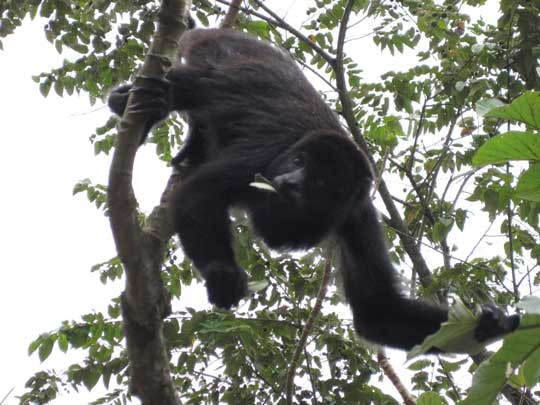
That was on the first day, and then later that evening, we had our first opportunity to listen to the behavior that gave these monkeys their name. When howler monkeys feel threatened, and especially when one troop comes upon a second troop, they howl. I mean they really howl. Not only is it amazingly loud, it also sounds kind of haunting and ominous. I didn't get a recording of the black howlers in Belize, but a few years later Trish and I were canoeing in Costa Rica when two troops of mantled howler monkeys got into a dispute, howling at each other across the river from both sides of us.
Here's a video I recorded of that dispute .
Be sure to turn your speakers up to fully appreciate their howling.
Amazingly, these calls can be heard up to three miles away!
What the heck is a Howler Monkey?
Howler monkeys are some of the largest monkeys that live in Central and South America. Howlers, of course, are monkeys, which means they are in the order Primates. There are fifteen species of howler monkeys, all of them in the family Atelidae.
Howlers are the only New World monkeys that are folivores. This means they eat leaves. They also eat flowers, nuts, and fruits, but they mostly love eating the leaves at the top of the canopy. Needless to say, they must be fantastic climbers in order to do this.
Amazing facts about Howler Monkeys
I'm going to focus mainly on one thing—the howler's reputation for being extremely loud. Why do they have this reputation? Because they are extremely loud! They are actually in the Guinness Book Of World Records as the loudest land animal.
This cacophonous call is possible because male howlers have extra-large throats. Also, they have a really cool hyoid bone. Usually, the hyoid is a horseshoe-shaped bone that helps with swallowing and tongue movement. But in howler monkeys, the bone has become a large resonating chamber in the throat. See the image below.

You could certainly hear the mantled howlers in my video above, but the monkeys themselves weren't very visible. You really need to see one of these monkeys up close as it is calling, so...
Check out this video of a Red Howler Monkey!
Now, the next question is, why do howler monkeys call so loudly? Howler monkeys are highly territorial. They live in troops of six to fifteen monkeys, and they howl to broadcast their position to other troops, warning them to keep their distance. When one troop actually comes within sight of another, the resulting shouting match can be impressive.
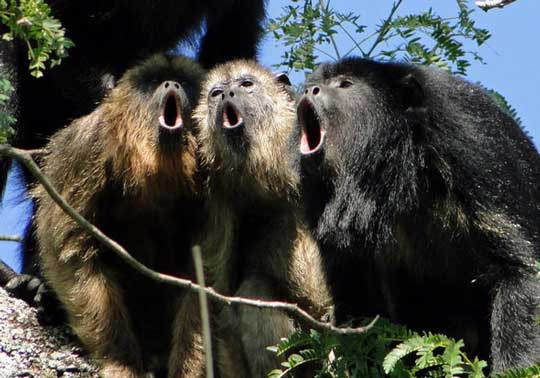
Wait! There's more to the story.
Yes, howling is a way to defend their territory, but that's not all. This howling behavior is also very important for communication within a howler monkey troop. In fact, this is a primary way for the males to attract mates.
In many animals, the males have certain physical features for impressing the females: a peacock's (and a turkey's) tail feathers, a deer's antlers, a drake mallard's bright green head, and many others. But in howler monkeys, volume is king. Louder males tend to get the females. So, it's not surprising that males have huge hyoids and females don't.
Warning: If you are reading this to your young kids, you are now entering the territory of mating habits, sperm cells, and testicles.
Now, let's explore this even further. Recent studies have shown that howler monkeys with larger hyoids (louder calls) have smaller testicles. Monkeys with smaller hyoids (quieter call) have larger testicles.
Hmm... interesting. I should explain.
Important Fact #1:
We all know what testicles are for, right? Just in case you aren't sure, testicles produce sperm cells. Sperm cells are necessary for a male to impregnate a female, thus producing offspring. The larger the testicles, the more sperm cells the male can produce. For a male howler, producing more sperm cells is a good thing.
Important Fact #2:
For a male howler, it's also a good thing to have a larger hyoid. Why? Because a larger hyoid results in a louder, lower voice. Guess what kind of voice is most appealing to the females... yep, a louder, lower voice.
Important Fact #3:
Both of these features are expensive. By expensive, I mean they take a lot of energy to produce. So, it's a tradeoff—male howlers can have large hyoids, or they can have large testicles, but they can't have both. Bummer.
The Amazing Result:
Some species of howlers live in groups in which there is only one male and many females. In these species, the males try to attract as many females as possible (otherwise they'll end up living alone). How do they attract all these females? By having a loud, deep call (a large hyoid but small testicles).
Other species live in groups in which there are numerous males instead of just one. In these species, it is helpful for the male to produce lots of sperm (large testicles but small hyoid). Why does it help for them to make lots of sperm? Because in these species the competition for mates comes aftercopulation. A greater volume of sperm gives these males a better chance of impregnating a female. Each female mates with all the males, and so all those sperm cells are racing to fertilize the egg. The more runners a male has in the race, the better chance he has of winning. Make sense?
Below is a male howler monkey. As you can probably guess, this is a species with a relatively small hyoid bone.
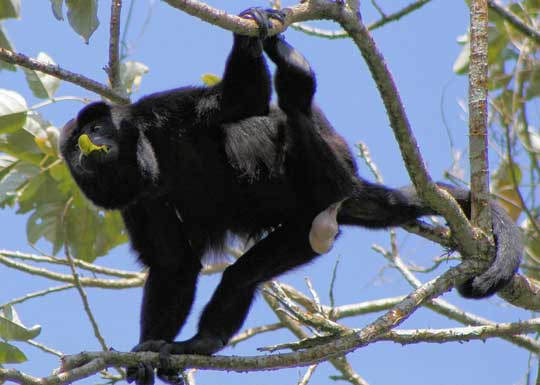
So, the Howler Monkey deserves a place in the S.A.H.O.F.
(Sick Animal Hall of Fame).
FUN FACT: The word sick originated before the year 900. It has always had the meaning, afflicted with ill health or disease. However, in the 1980s, the word became popular with surfers and skateboarders as a way to express "shock and awe" after seeing something amazing ("that stunt was sick"). Now it is used to praise just about anything (that episode of The Simpsons was sick!). So, sick is another way to say awesome!
Photo Credits:
Black Howler in Belize - Stan C. Smith
Howler skeleton with Hyoid - Evolutionary Literacy
Three Howlers howling - Mariana Raño via Scientific American
Black howler monkey with testicles - Scott Robinson vis Slate
It was 2010. Trish and I saved up our hard-earned pennies, and we traveled to Belize. At a place called Lamanai, where there are some fascinating Mayan ruins, a black howler monkey came down in a tree within a few meters of us, allowing me to get a decent photo:

That was on the first day, and then later that evening, we had our first opportunity to listen to the behavior that gave these monkeys their name. When howler monkeys feel threatened, and especially when one troop comes upon a second troop, they howl. I mean they really howl. Not only is it amazingly loud, it also sounds kind of haunting and ominous. I didn't get a recording of the black howlers in Belize, but a few years later Trish and I were canoeing in Costa Rica when two troops of mantled howler monkeys got into a dispute, howling at each other across the river from both sides of us.
Here's a video I recorded of that dispute .
Be sure to turn your speakers up to fully appreciate their howling.
Amazingly, these calls can be heard up to three miles away!
What the heck is a Howler Monkey?
Howler monkeys are some of the largest monkeys that live in Central and South America. Howlers, of course, are monkeys, which means they are in the order Primates. There are fifteen species of howler monkeys, all of them in the family Atelidae.
Howlers are the only New World monkeys that are folivores. This means they eat leaves. They also eat flowers, nuts, and fruits, but they mostly love eating the leaves at the top of the canopy. Needless to say, they must be fantastic climbers in order to do this.
Amazing facts about Howler Monkeys
I'm going to focus mainly on one thing—the howler's reputation for being extremely loud. Why do they have this reputation? Because they are extremely loud! They are actually in the Guinness Book Of World Records as the loudest land animal.
This cacophonous call is possible because male howlers have extra-large throats. Also, they have a really cool hyoid bone. Usually, the hyoid is a horseshoe-shaped bone that helps with swallowing and tongue movement. But in howler monkeys, the bone has become a large resonating chamber in the throat. See the image below.

You could certainly hear the mantled howlers in my video above, but the monkeys themselves weren't very visible. You really need to see one of these monkeys up close as it is calling, so...
Check out this video of a Red Howler Monkey!
Now, the next question is, why do howler monkeys call so loudly? Howler monkeys are highly territorial. They live in troops of six to fifteen monkeys, and they howl to broadcast their position to other troops, warning them to keep their distance. When one troop actually comes within sight of another, the resulting shouting match can be impressive.

Wait! There's more to the story.
Yes, howling is a way to defend their territory, but that's not all. This howling behavior is also very important for communication within a howler monkey troop. In fact, this is a primary way for the males to attract mates.
In many animals, the males have certain physical features for impressing the females: a peacock's (and a turkey's) tail feathers, a deer's antlers, a drake mallard's bright green head, and many others. But in howler monkeys, volume is king. Louder males tend to get the females. So, it's not surprising that males have huge hyoids and females don't.
Warning: If you are reading this to your young kids, you are now entering the territory of mating habits, sperm cells, and testicles.
Now, let's explore this even further. Recent studies have shown that howler monkeys with larger hyoids (louder calls) have smaller testicles. Monkeys with smaller hyoids (quieter call) have larger testicles.
Hmm... interesting. I should explain.
Important Fact #1:
We all know what testicles are for, right? Just in case you aren't sure, testicles produce sperm cells. Sperm cells are necessary for a male to impregnate a female, thus producing offspring. The larger the testicles, the more sperm cells the male can produce. For a male howler, producing more sperm cells is a good thing.
Important Fact #2:
For a male howler, it's also a good thing to have a larger hyoid. Why? Because a larger hyoid results in a louder, lower voice. Guess what kind of voice is most appealing to the females... yep, a louder, lower voice.
Important Fact #3:
Both of these features are expensive. By expensive, I mean they take a lot of energy to produce. So, it's a tradeoff—male howlers can have large hyoids, or they can have large testicles, but they can't have both. Bummer.
The Amazing Result:
Some species of howlers live in groups in which there is only one male and many females. In these species, the males try to attract as many females as possible (otherwise they'll end up living alone). How do they attract all these females? By having a loud, deep call (a large hyoid but small testicles).
Other species live in groups in which there are numerous males instead of just one. In these species, it is helpful for the male to produce lots of sperm (large testicles but small hyoid). Why does it help for them to make lots of sperm? Because in these species the competition for mates comes aftercopulation. A greater volume of sperm gives these males a better chance of impregnating a female. Each female mates with all the males, and so all those sperm cells are racing to fertilize the egg. The more runners a male has in the race, the better chance he has of winning. Make sense?
Below is a male howler monkey. As you can probably guess, this is a species with a relatively small hyoid bone.

So, the Howler Monkey deserves a place in the S.A.H.O.F.
(Sick Animal Hall of Fame).
FUN FACT: The word sick originated before the year 900. It has always had the meaning, afflicted with ill health or disease. However, in the 1980s, the word became popular with surfers and skateboarders as a way to express "shock and awe" after seeing something amazing ("that stunt was sick"). Now it is used to praise just about anything (that episode of The Simpsons was sick!). So, sick is another way to say awesome!
Photo Credits:
Black Howler in Belize - Stan C. Smith
Howler skeleton with Hyoid - Evolutionary Literacy
Three Howlers howling - Mariana Raño via Scientific American
Black howler monkey with testicles - Scott Robinson vis Slate
Published on November 12, 2019 04:45
October 29, 2019
Awesome Animal - Tasmanian Tiger
You know, there are some animals that humans really wish still existed. One example is the ivory-billed woodpecker in North America. The last universally-accepted sighting of an ivory-billed woodpecker was in Louisiana in 1944. But diehard birders never stop searching, hoping to be the first to discover that this species still exists. And there are numerous unconfirmed sightings. So I guess the ivory-billed woodpecker is kind of like Elvis.
In Australia, and particularly in the Australian island state of Tasmania, people are still looking for the Tasmanian tiger, also known as the Thylocine. Yep, they're still looking, even though the last of these creatures died in 1936.
The Tasmanian tiger is, no doubt, an awesome animal, so let's take a closer look. We'll also take a closer look at the never-ending search for this creature.
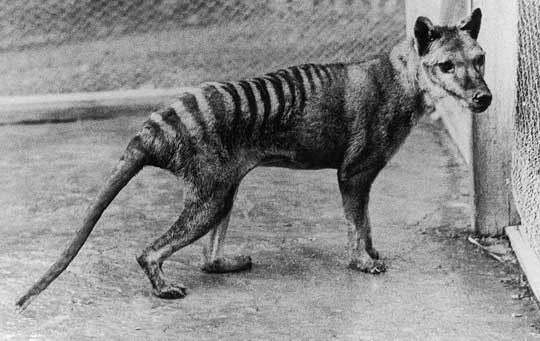
What the heck is a Tasmanian Tiger (Thylacine)?
First, the thylacine is a marsupial. You know what marsupials are, right? They are a group of mammals that give birth to very small young, which are then nurtured in an external pouch (includes kangaroos, koalas, opossums, wombats, and many more). Placental mammals (including humans), on the other hand, nurture the fetus inside the body, with a placenta that helps exchange nutrients and waste between the mother's blood and the fetus.
The thylacine is one of the largest known carnivorous marsupial (marsupials that prey on other animals). At one time, the thylacine was fairly common in Tasmania, New Guinea, and throughout the Australian mainland. The thylacine was what we call an apex predator, which means it was at the top of the food chain in its range (it had no natural predators).
Although the thylacine is not related to dogs, it has a general dog shape. Because of this, it is sometimes called the Tasmanian wolf. The name Tasmanian tiger comes from the row of stripes on its back.
Amazing facts about the Thylacine
The thylacine is one of only two marsupials in which both males and females have a pouch. You already know what the female's pouch is for. The male's pouch serves as a protective covering for the external reproductive organs. Wait, what? That sounds like a no-brainer. Why don't all male mammals have those? Anyway, the only other marsupial that has this protective pouch in males is the water opossum.
The thylacine is a great example of what we call convergent evolution, in which unrelated creatures end up having similar structures because they have become well adapted to similar niches. The thylacine filled the same ecological niche in Australia as the dog has filled in other areas of the world. That's why it looks similar to a dog!
The skull below on the left is from a thylacine, and the skull on the right is from a timber wolf. Notice how similar they look, even though they are not closely related at all.

Since these creatures went extinct in the 1930s, we don't know much about their behavior. But from early recorded observations, we know that they ran with an odd, stiff gait, which made it difficult for the animal to run very fast. Occasionally they were also observed hopping on their back legs like a kangaroo. It is thought that they used this hopping motion when startled.
The thylacine also had an amazing ability to open its mouth, spreading its jaws to 80 degrees! Here's a 1933 photo of a thylacine yawning (which is a threat gesture). What a mouth!
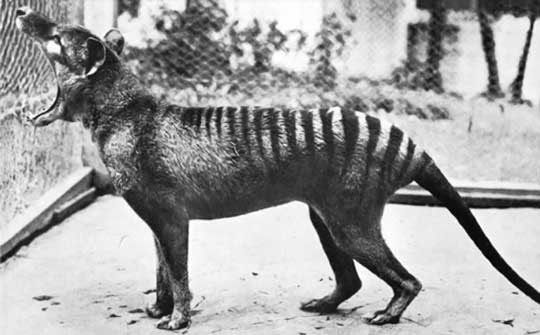
How did the thylacine go extinct?
As stated above, thylacines once lived throughout mainland Australia and in parts of New Guinea. They went extinct in these places about 2,000 years ago. Although there is disagreement as to how the creature went extinct on the mainland, it is thought to be at least partly due to the arrival of the dingo (a dog native to Australia). But more recent studies suggest it may have been caused more by climate change and by the way Aborigines used the land. The dingo theory is debatable because the two animals are thought to have different hunting habits and prey. Why does this matter? Because if they had different prey, they probably did not compete with each other as much as we once thought.
However, the thylacines that had been isolated on the island of Tasmania escaped this fate (maybe because there are no dingoes on Tasmania). Even so, only about 5000 thylacines still lived in Tasmania when the first Europeans settled on the island in 1803.
This is when things really went downhill for the Tasmanian tiger. Soon after Europeans settled on Tasmania, they started complaining that thylacines were killing their sheep. Actually, there was more evidence that feral dogs and poor farming habits were really the culprits, but the farmers must have decided that the thylacine was easier to blame. By the 1830s, the farmers pooled their money and established a system of bounties for killing thylacines. And then the government started awarding bounties. By the time this practice ended in 1909, a total of 2,180 bounties had been awarded.
Below is a photo of a hunter posing with his "trophy" in 1869.
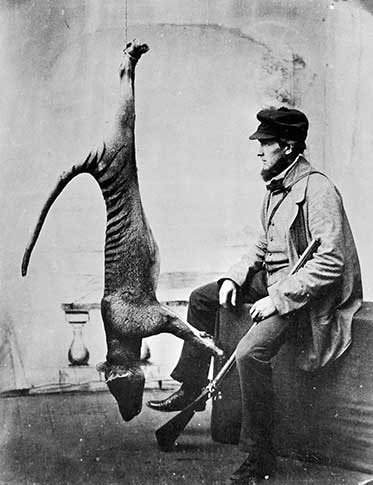
This excessive hunting, combined with habitat destruction, the introduction of foreign diseases, and competition from feral dogs decimated the population, and the last thylacine in the wild was shot in 1930.
At that time there was a shift in public opinion about thylacines, and preservation measures were put in place. But—you guessed it—this was far too late. Just 59 days after the species was granted "protected" status, the last individual in captivity died at the Hobart Zoo. Its name was Benjamin, and it died because the zookeepers accidentally locked Benjamin out of his sheltered sleeping quarters on a very cold night (I should point out, though, that these details about the name and the accident are now being challenged and may not be accurate).
Here is a photo of Benjamin, taken in 1936, not long before he died:
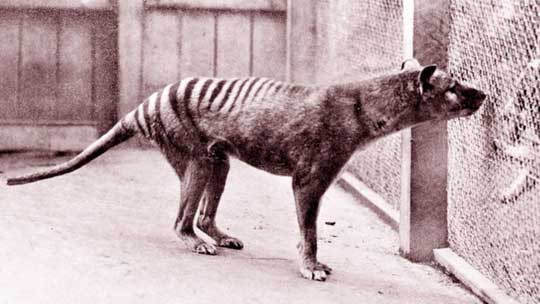
People are still searching for Tasmanian tigers
Ever since the thylacine's extinction, many Australians have searched for these animals. In fact, some have devoted their entire lives to the search. But no definitive evidence has ever been found. No definite photos, no definite videos, no definite sightings by highly-qualified scientists.
You might be tempted to equate this with the search for Bigfoot in North America, or the search for "Nessie" in Loch Ness in Scotland. But... remember that the thylacine is a REAL animal, and it definitely lived only 83 years ago. Is it likely to be alive? Probably not. Is it possible ? Absolutely.
And what's interesting is that people have consistently reported sightings over the last 80 years. In Tasmania, hundreds of unconfirmed sightings have been reported. Astoundingly, 65 sighting have been reported on the Australian mainland, particularly in the southwest portion of Western Australia. And more recently sightings have been reported in northern Queensland. But... not one single confirmed photo, video, or sighting.
Hmm... What do you think? With all the technology we now have, especially trail cameras, wouldn't we have at least ONE definitive video or photo?
Perhaps the most intriguing video was captured by teacher Paul Day. Paul was photographing the sunrise in the Yorke Peninsula in northern Queensland when a creature ran across a field in front of him. The creature's strange hopping gait is much like what observers have described for the thylacine.
Check out the video!
I know, we all want to believe the Tasmanian tiger still exists. How cool would that be? But, perhaps we should remain skeptical, at least until someone comes up with undeniable proof.
Again, what do you think?
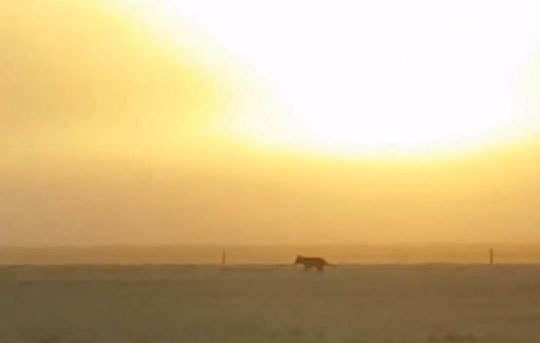
So, the Tasmanian Tiger deserves a place in the. B.O.A.A.H.O.F.
(Bit of Alright Animal Hall of Fame).
FUN FACT: The phrase bit of alright, as far as I can tell, is mainly used in Australia (making it especially suitable for the thylacine) and Great Britain. Typically it is used to describe someone as physically attractive (Example: "He's a bit of all right, isn't he?" said Isadora, looking at a tall man near the door.). Well, the Tasmanian tiger, in my opinion, is a very attractive creature (as extinct marsupials go), so bit of alright is another way to say awesome!
Photo Credits:
Tasmanian tiger #1 - Tasmanian Museum and Art Gallery via National Museum Australia
Thylacine and wolf skulls - Wikipedia
Tasmanian tiger yawning - Tasmanian Museum and Art Gallery via University of Melbourne
Tasmanian Tiger (Benjamin) - Getty Images via Foxnews.com
Screen shot of Paul Day's Video - National Geographic
In Australia, and particularly in the Australian island state of Tasmania, people are still looking for the Tasmanian tiger, also known as the Thylocine. Yep, they're still looking, even though the last of these creatures died in 1936.
The Tasmanian tiger is, no doubt, an awesome animal, so let's take a closer look. We'll also take a closer look at the never-ending search for this creature.

What the heck is a Tasmanian Tiger (Thylacine)?
First, the thylacine is a marsupial. You know what marsupials are, right? They are a group of mammals that give birth to very small young, which are then nurtured in an external pouch (includes kangaroos, koalas, opossums, wombats, and many more). Placental mammals (including humans), on the other hand, nurture the fetus inside the body, with a placenta that helps exchange nutrients and waste between the mother's blood and the fetus.
The thylacine is one of the largest known carnivorous marsupial (marsupials that prey on other animals). At one time, the thylacine was fairly common in Tasmania, New Guinea, and throughout the Australian mainland. The thylacine was what we call an apex predator, which means it was at the top of the food chain in its range (it had no natural predators).
Although the thylacine is not related to dogs, it has a general dog shape. Because of this, it is sometimes called the Tasmanian wolf. The name Tasmanian tiger comes from the row of stripes on its back.
Amazing facts about the Thylacine
The thylacine is one of only two marsupials in which both males and females have a pouch. You already know what the female's pouch is for. The male's pouch serves as a protective covering for the external reproductive organs. Wait, what? That sounds like a no-brainer. Why don't all male mammals have those? Anyway, the only other marsupial that has this protective pouch in males is the water opossum.
The thylacine is a great example of what we call convergent evolution, in which unrelated creatures end up having similar structures because they have become well adapted to similar niches. The thylacine filled the same ecological niche in Australia as the dog has filled in other areas of the world. That's why it looks similar to a dog!
The skull below on the left is from a thylacine, and the skull on the right is from a timber wolf. Notice how similar they look, even though they are not closely related at all.

Since these creatures went extinct in the 1930s, we don't know much about their behavior. But from early recorded observations, we know that they ran with an odd, stiff gait, which made it difficult for the animal to run very fast. Occasionally they were also observed hopping on their back legs like a kangaroo. It is thought that they used this hopping motion when startled.
The thylacine also had an amazing ability to open its mouth, spreading its jaws to 80 degrees! Here's a 1933 photo of a thylacine yawning (which is a threat gesture). What a mouth!

How did the thylacine go extinct?
As stated above, thylacines once lived throughout mainland Australia and in parts of New Guinea. They went extinct in these places about 2,000 years ago. Although there is disagreement as to how the creature went extinct on the mainland, it is thought to be at least partly due to the arrival of the dingo (a dog native to Australia). But more recent studies suggest it may have been caused more by climate change and by the way Aborigines used the land. The dingo theory is debatable because the two animals are thought to have different hunting habits and prey. Why does this matter? Because if they had different prey, they probably did not compete with each other as much as we once thought.
However, the thylacines that had been isolated on the island of Tasmania escaped this fate (maybe because there are no dingoes on Tasmania). Even so, only about 5000 thylacines still lived in Tasmania when the first Europeans settled on the island in 1803.
This is when things really went downhill for the Tasmanian tiger. Soon after Europeans settled on Tasmania, they started complaining that thylacines were killing their sheep. Actually, there was more evidence that feral dogs and poor farming habits were really the culprits, but the farmers must have decided that the thylacine was easier to blame. By the 1830s, the farmers pooled their money and established a system of bounties for killing thylacines. And then the government started awarding bounties. By the time this practice ended in 1909, a total of 2,180 bounties had been awarded.
Below is a photo of a hunter posing with his "trophy" in 1869.

This excessive hunting, combined with habitat destruction, the introduction of foreign diseases, and competition from feral dogs decimated the population, and the last thylacine in the wild was shot in 1930.
At that time there was a shift in public opinion about thylacines, and preservation measures were put in place. But—you guessed it—this was far too late. Just 59 days after the species was granted "protected" status, the last individual in captivity died at the Hobart Zoo. Its name was Benjamin, and it died because the zookeepers accidentally locked Benjamin out of his sheltered sleeping quarters on a very cold night (I should point out, though, that these details about the name and the accident are now being challenged and may not be accurate).
Here is a photo of Benjamin, taken in 1936, not long before he died:

People are still searching for Tasmanian tigers
Ever since the thylacine's extinction, many Australians have searched for these animals. In fact, some have devoted their entire lives to the search. But no definitive evidence has ever been found. No definite photos, no definite videos, no definite sightings by highly-qualified scientists.
You might be tempted to equate this with the search for Bigfoot in North America, or the search for "Nessie" in Loch Ness in Scotland. But... remember that the thylacine is a REAL animal, and it definitely lived only 83 years ago. Is it likely to be alive? Probably not. Is it possible ? Absolutely.
And what's interesting is that people have consistently reported sightings over the last 80 years. In Tasmania, hundreds of unconfirmed sightings have been reported. Astoundingly, 65 sighting have been reported on the Australian mainland, particularly in the southwest portion of Western Australia. And more recently sightings have been reported in northern Queensland. But... not one single confirmed photo, video, or sighting.
Hmm... What do you think? With all the technology we now have, especially trail cameras, wouldn't we have at least ONE definitive video or photo?
Perhaps the most intriguing video was captured by teacher Paul Day. Paul was photographing the sunrise in the Yorke Peninsula in northern Queensland when a creature ran across a field in front of him. The creature's strange hopping gait is much like what observers have described for the thylacine.
Check out the video!
I know, we all want to believe the Tasmanian tiger still exists. How cool would that be? But, perhaps we should remain skeptical, at least until someone comes up with undeniable proof.
Again, what do you think?

So, the Tasmanian Tiger deserves a place in the. B.O.A.A.H.O.F.
(Bit of Alright Animal Hall of Fame).
FUN FACT: The phrase bit of alright, as far as I can tell, is mainly used in Australia (making it especially suitable for the thylacine) and Great Britain. Typically it is used to describe someone as physically attractive (Example: "He's a bit of all right, isn't he?" said Isadora, looking at a tall man near the door.). Well, the Tasmanian tiger, in my opinion, is a very attractive creature (as extinct marsupials go), so bit of alright is another way to say awesome!
Photo Credits:
Tasmanian tiger #1 - Tasmanian Museum and Art Gallery via National Museum Australia
Thylacine and wolf skulls - Wikipedia
Tasmanian tiger yawning - Tasmanian Museum and Art Gallery via University of Melbourne
Tasmanian Tiger (Benjamin) - Getty Images via Foxnews.com
Screen shot of Paul Day's Video - National Geographic
Published on October 29, 2019 04:57
October 16, 2019
Awesome Animal - Tuatara
Way back in 1995, Trish and I had a special opportunity to visit New Zealand with a group of about thirty other science teachers. One of the places we visited was the Aukland Zoo. What a spectacular place! I was thrilled to see so many animals that I had never seen before other than in photographs. But what I most anticipated seeing was the tuatara.
At first glance the tuatara looks like a lizard, like a rather bland version of some kind of iguana. But I knew that this creature was much, much more than that. The tuatara is, in fact, one of the most unusual reptiles alive today. Read on to learn more...

What the heck is a Tuatara?
Tuataras look like lizards, but they aren't lizards. Lizards and snakes belong in an order called Squamata. The tuatara is in a completely different order all by itself, called Rhynchocephalia. That's a mouthful: rink-oh-ceph-ale-ya.
Only one species of Rhynchocephalia (the tuatara) survives today, and it only lives in New Zealand. But there was a time, millions of years ago when dinosaurs roamed the earth, when there were many species, even some bizarre marine species. The Rhynchocephalia were once probably as abundant as lizards are today.
Why is the tuatara NOT a lizard? Hmm... where to begin...
Amazing facts about the Tuatara
Back in 1831, a British zoologist by the name of John Edward Gray discovered the tuatara (yes, I know—he didn't really discover the species... the native Maori were aware of it long before then). He sent a skeleton to the British Museum, and it was misidentified as a lizard. It wasn't until 1867 that another scientist named Albert Günther examined the skeleton and realized that it actually had features seen in crocodiles, turtles, and birds! So Günther proposed creating the order Rhynchocephalia just for this creature.
So we've known for 152 years that the tuatara is not a lizard!
If the tuatara isn't a lizard, is it a dinosaur? Nope, not a dinosaur either, although they were abundant while dinosaurs were around.
First, to fully appreciate how unique the tuatara is, let's consider this: The huge group of animals called “amniote vertebrates” includes mammals (5,416 species), turtles (341 species), birds (15,845 species), crocodylians (25 species), lizards and snakes (10,078 species). And then there's the Rhynchocephalia... with ONE species, the tuatara!
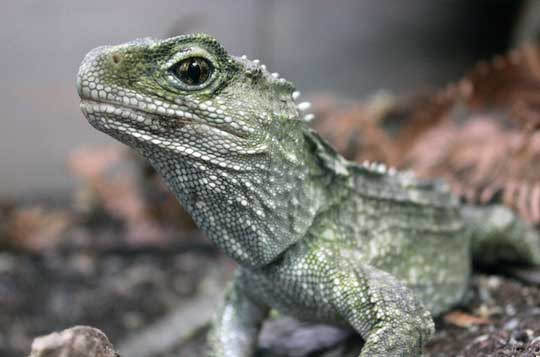
Let's look at what makes tuataras so unique. First, they have a third eye. What? A third eye? Well, kind of. This third eye is situated just where you would expect it to be—on top of the forehead. It's actually known as a parietal eye. It really does have a lens and a retina, but it is more primitive than the tuatara's regular eyes, and can mostly just detect the presence or absence of light. The exact purpose of the eye is not fully understood, but it is thought to help the tuatara judge the time of day and the season, which would help it with thermoregulation (maintaining its body temperature).
I should point out that tuataras are not the only animals to have parietal eyes. They are found in some burrowing lizards, some frogs, and some fish, including sharks. But the parietal eyes of the tuatara are more developed than these others. The photo below points out where the parietal eye is on a tuatara.
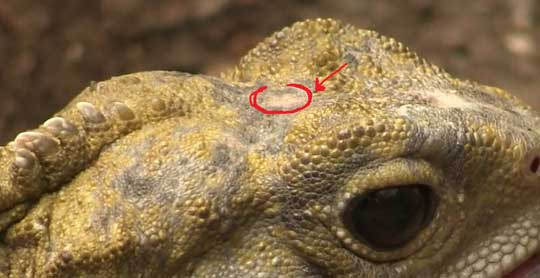
One of the most distinctive features of tuataras (that sets them apart from other reptiles) is that they have a second row of upper teeth. When they close their mouths, the one row of teeth on the lower jaw fits nicely between the two rows on the upper jaw. Actually, they are not even real teeth at all. Unlike other reptiles, their teeth are not separate structures. Instead, they are simply sharp projections of the jaw bone. Therefore, the "teeth" are not replaced when they break off. Because of this, the "teeth" gradually get worn down as the tuatara grows older. So, old tuataras have to switch to eating only soft prey like earthworms and grubs. Eventually they have to chew their food with nothing more than smooth jaw bones. Too bad old tuataras can't get dentures, huh?
Check out the tuatara skull below. You can see the rows of "teeth" on the sides. You can also see the beak-like front teeth (lizards don't have those), as well as the strange arches behind the eyes (lizards don't have those either). There are other aspects of this skull that separates tuataras from lizards, but I have to be honest—they are beyond my ability to accurately describe them!

Speaking of those "teeth," tuataras do not chew like lizards chew. Instead of chewing up and down, the jaws of tuataras have a forward-and-backward sawing motion, slicing food like a steak knife. This apparently works well—tuataras can chew through chiton and bone. It allows them to eat tougher prey. In fact, they are known to decapitate birds (headless bird bodies are often found near tuatara nests).
Tuataras are extremely tolerant of cold (for a reptile). I seem to remember a Gary Larson cartoon with a crocodile on the witness stand angrily telling the prosecutor, “Well, of course I did it in cold blood, you idiot! I’m a reptile!” But in reality, most reptiles become very lethargic in colder temperatures (making it so that the crocodile would be incapable of committing the crime in question). But not so the tuatara. They have a unique type of hemoglobin in their blood that allow them to be active at temperatures only a few degrees above freezing. Not only that, but they can hold their breath for up to an hour!
This slow metabolism makes it so that tuataras have really slow development and really long lifespans. I mean really long. It takes a tuatara a whopping 14 years to reach sexual maturity, and it takes 35 year for them to be fully grown. Once mature, it takes the females up to three years to produce eggs with yolk. And THEN it takes twelve to fifteen months from copulation to hatching! During that time, it takes up to seven months just to form the egg shells. Yeesh. Not in much of a hurry, are they?
Check out this video about hatchling tuataras.
So, if it takes 35 years to grow up, how long can these things live? Astoundingly, the oldest tuatara that we know of is Henry. Henry the tuatara lives in the Southland Museum in Invercargill, New Zealand. Henry became a celebrity when he finally decided to mate with a female at the age of 111 (like I said, not in a hurry). That was in 2009, so now Henry is 121 years old. Henry had the honor of meeting Prince Harry at the age of 118 (that was the age of Henry, not Prince Harry).
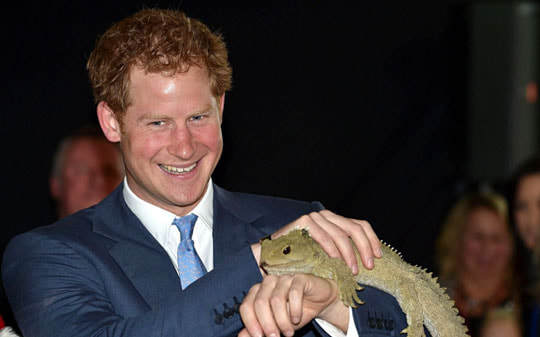
So, the tuatara deserves a place in the. F.A.H.O.F.
(Fabuloso Animal Hall of Fame).
FUN FACT: The word fabuloso comes from the Latin fābulōsus (which means fabulous, great, wonderful). It is somewhat difficult to trace the origins of its use in the English language because it is also used in several other languages (including Portuguese and Spanish). But from what I can tell, it is used to add a particular stylistic flair to the word fabulous (making it more flamboyant and expressive). Oddly enough, it is also the name of a multi-purpose cleaner used for cleaning bathrooms, tile floors, and such. Anyway, fabuloso is another way to say awesome!
Photo Credits:
Tuatara #1 - San Diego Zoo
Tuatara #2 - somaholiday/Flickr via AustralianGeographic.com
Parietal eye - c00lbeans69 via Imgur
Tuatara skull - Museum of New Zealand
Henry with Prince Harry - Tim Rooke/REX Shutterstock via The Telegraph
At first glance the tuatara looks like a lizard, like a rather bland version of some kind of iguana. But I knew that this creature was much, much more than that. The tuatara is, in fact, one of the most unusual reptiles alive today. Read on to learn more...

What the heck is a Tuatara?
Tuataras look like lizards, but they aren't lizards. Lizards and snakes belong in an order called Squamata. The tuatara is in a completely different order all by itself, called Rhynchocephalia. That's a mouthful: rink-oh-ceph-ale-ya.
Only one species of Rhynchocephalia (the tuatara) survives today, and it only lives in New Zealand. But there was a time, millions of years ago when dinosaurs roamed the earth, when there were many species, even some bizarre marine species. The Rhynchocephalia were once probably as abundant as lizards are today.
Why is the tuatara NOT a lizard? Hmm... where to begin...
Amazing facts about the Tuatara
Back in 1831, a British zoologist by the name of John Edward Gray discovered the tuatara (yes, I know—he didn't really discover the species... the native Maori were aware of it long before then). He sent a skeleton to the British Museum, and it was misidentified as a lizard. It wasn't until 1867 that another scientist named Albert Günther examined the skeleton and realized that it actually had features seen in crocodiles, turtles, and birds! So Günther proposed creating the order Rhynchocephalia just for this creature.
So we've known for 152 years that the tuatara is not a lizard!
If the tuatara isn't a lizard, is it a dinosaur? Nope, not a dinosaur either, although they were abundant while dinosaurs were around.
First, to fully appreciate how unique the tuatara is, let's consider this: The huge group of animals called “amniote vertebrates” includes mammals (5,416 species), turtles (341 species), birds (15,845 species), crocodylians (25 species), lizards and snakes (10,078 species). And then there's the Rhynchocephalia... with ONE species, the tuatara!

Let's look at what makes tuataras so unique. First, they have a third eye. What? A third eye? Well, kind of. This third eye is situated just where you would expect it to be—on top of the forehead. It's actually known as a parietal eye. It really does have a lens and a retina, but it is more primitive than the tuatara's regular eyes, and can mostly just detect the presence or absence of light. The exact purpose of the eye is not fully understood, but it is thought to help the tuatara judge the time of day and the season, which would help it with thermoregulation (maintaining its body temperature).
I should point out that tuataras are not the only animals to have parietal eyes. They are found in some burrowing lizards, some frogs, and some fish, including sharks. But the parietal eyes of the tuatara are more developed than these others. The photo below points out where the parietal eye is on a tuatara.

One of the most distinctive features of tuataras (that sets them apart from other reptiles) is that they have a second row of upper teeth. When they close their mouths, the one row of teeth on the lower jaw fits nicely between the two rows on the upper jaw. Actually, they are not even real teeth at all. Unlike other reptiles, their teeth are not separate structures. Instead, they are simply sharp projections of the jaw bone. Therefore, the "teeth" are not replaced when they break off. Because of this, the "teeth" gradually get worn down as the tuatara grows older. So, old tuataras have to switch to eating only soft prey like earthworms and grubs. Eventually they have to chew their food with nothing more than smooth jaw bones. Too bad old tuataras can't get dentures, huh?
Check out the tuatara skull below. You can see the rows of "teeth" on the sides. You can also see the beak-like front teeth (lizards don't have those), as well as the strange arches behind the eyes (lizards don't have those either). There are other aspects of this skull that separates tuataras from lizards, but I have to be honest—they are beyond my ability to accurately describe them!

Speaking of those "teeth," tuataras do not chew like lizards chew. Instead of chewing up and down, the jaws of tuataras have a forward-and-backward sawing motion, slicing food like a steak knife. This apparently works well—tuataras can chew through chiton and bone. It allows them to eat tougher prey. In fact, they are known to decapitate birds (headless bird bodies are often found near tuatara nests).
Tuataras are extremely tolerant of cold (for a reptile). I seem to remember a Gary Larson cartoon with a crocodile on the witness stand angrily telling the prosecutor, “Well, of course I did it in cold blood, you idiot! I’m a reptile!” But in reality, most reptiles become very lethargic in colder temperatures (making it so that the crocodile would be incapable of committing the crime in question). But not so the tuatara. They have a unique type of hemoglobin in their blood that allow them to be active at temperatures only a few degrees above freezing. Not only that, but they can hold their breath for up to an hour!
This slow metabolism makes it so that tuataras have really slow development and really long lifespans. I mean really long. It takes a tuatara a whopping 14 years to reach sexual maturity, and it takes 35 year for them to be fully grown. Once mature, it takes the females up to three years to produce eggs with yolk. And THEN it takes twelve to fifteen months from copulation to hatching! During that time, it takes up to seven months just to form the egg shells. Yeesh. Not in much of a hurry, are they?
Check out this video about hatchling tuataras.
So, if it takes 35 years to grow up, how long can these things live? Astoundingly, the oldest tuatara that we know of is Henry. Henry the tuatara lives in the Southland Museum in Invercargill, New Zealand. Henry became a celebrity when he finally decided to mate with a female at the age of 111 (like I said, not in a hurry). That was in 2009, so now Henry is 121 years old. Henry had the honor of meeting Prince Harry at the age of 118 (that was the age of Henry, not Prince Harry).

So, the tuatara deserves a place in the. F.A.H.O.F.
(Fabuloso Animal Hall of Fame).
FUN FACT: The word fabuloso comes from the Latin fābulōsus (which means fabulous, great, wonderful). It is somewhat difficult to trace the origins of its use in the English language because it is also used in several other languages (including Portuguese and Spanish). But from what I can tell, it is used to add a particular stylistic flair to the word fabulous (making it more flamboyant and expressive). Oddly enough, it is also the name of a multi-purpose cleaner used for cleaning bathrooms, tile floors, and such. Anyway, fabuloso is another way to say awesome!
Photo Credits:
Tuatara #1 - San Diego Zoo
Tuatara #2 - somaholiday/Flickr via AustralianGeographic.com
Parietal eye - c00lbeans69 via Imgur
Tuatara skull - Museum of New Zealand
Henry with Prince Harry - Tim Rooke/REX Shutterstock via The Telegraph
Published on October 16, 2019 06:02
October 3, 2019
Awesome Animal - Dumbo Octopus
Did you know the most common (and accepted) plural word for octopus is octopuses? It is not octopi. Actually the proper word is octopodes. Here's why: If the word octopus had come from Latin (like syllabus or alumnus), the correct plural form would be octopi. But octopus actually came from Greek, and in Greek the correct plural is octopodes. But the word octopodes never really caught in, so most people use octopuses.
And... did you know octopuses are mollusks? Yep, they are in the same animal phylum as snails, slugs, clams, oysters, and squid (as well as many others). I know... they don't look anything like a snail or a clam, right?
AND... did you know there are about 300 species of octopuses? And if there is one type that deserves to have squishy toys made in its image—it has to be the dumbo octopus.
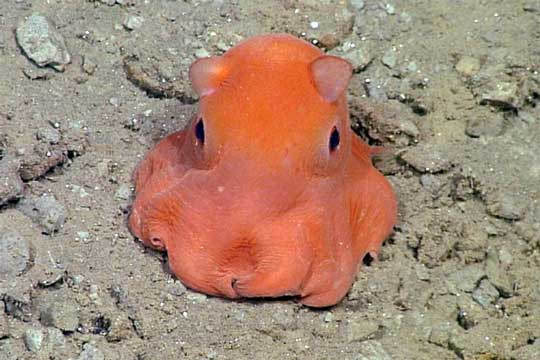
What the heck is a Dumbo Octopus?
Dumbo octopuses include about 13 species of umbrella octopuses (a group that kind of look like an umbrella when they spread their tentacles). The name dumbo comes from the fact that they have two fins that spread out above the eyes, resembling the oversized ears of Dumbo the elephant (from the 1941 animated Disney film). Actually, very little is known about the dumbo octopus, but we know enough to be confident that they are awesome! Let's take a look.
Amazing facts about the Dumbo Octopus
You're not going to see a dumbo octopus while you're out snorkeling in shallow water. Why? Because these octopuses live deep in the ocean. Most of them live at depths of about 13,000 feet (4,000 m), and some have been found as deep as 23,000 feet (7,000 m). That's over four miles down! Chances are, they live even deeper than that. This makes them by far the deepest living of all the octopuses.
Dumbo octopuses appear to move through the water by slowly flapping their ear-like fins, but actually they are gently squirting water from their tentacle-funnel, and their ear fins are providing stability and steering. They can also crawl along the sea floor with their tentacles (you can call them arms if you want, but I just like to say the word tentacles). Since these methods of movement are slow, to escape from predators they also can dart away by aggressively squeezing water out. They do this by expanding and contracting their tentacles, making use of the funnel-like webbing between their tentacles.
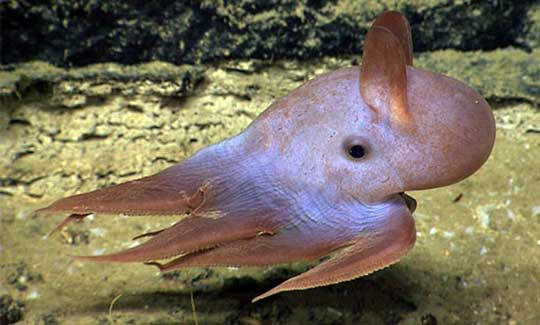
Dumbo octopuses are fairly small, averaging about 8 to 12 inches (20-30 cm) long, about the size of a guinea pig. But larger ones have been found. The largest of these was 5 feet 10 inches (1.8 m) long and weighed 13 pounds (5.9 kg). I guess you could call that one a jumbo dumbo octopus.
Since dumbo octopuses live so deep, they are not threatened much by human activity. But they do have to worry about sharks and predatory cephalopods (such as larger octopuses and squid).
Dumbo octopuses are quite rare and difficult to find, so we don't know much about their population size, and we really don't know if they are threatened or if they simply are naturally scarce.
Dumbo octopuses may look cute and cuddly, but they are efficient and deadly predators. They typically float around in the open water, gently flapping their "dumbo ears" (fins), and when they find a fish or other prey, they pounce on it quickly and swallow it in one gulp. Their most common prey animals include worms, various crustaceans, copepods, amphipods, and isopods (that's a lot of pods). Below is a dumbo octopus catching a fish.
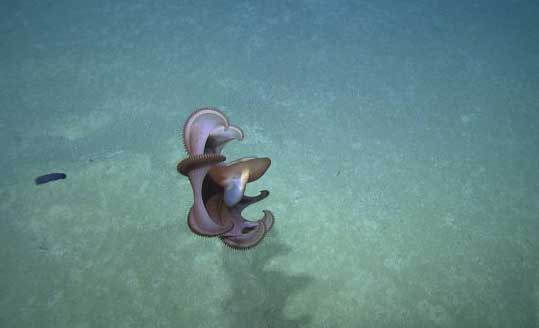
These creatures have a rather unusual sex life. First of all, there is no distinct season for breeding. Why? Because, this deep in the ocean, seasons don't have any significance. Not only that, but food is often scarce. And the ocean is a huge place! So these octopuses rarely encounter each other. So when a male does occasionally encounter a female, he uses a special protuberance on one of his arms to deliver a sperm packet into the female's mantle. The female then stores the sperm in her body and uses it when she happens to detect that her environment is favorable for laying eggs (kind of like putting a cookie in your pocket and saving it for later when you might get hungry). And, amazingly, the females usually have numerous eggs stored, and these eggs are at different stages of development, so that the female is ready with mature eggs whenever conditions happen to be right to fertilize the eggs and lay them (it's time to get that cookie out and munch on it).
The female typically lays her eggs attached to the bottoms of rocks on the ocean floor. In the photo below you can see the eyes of the developing embryos within the eggs.
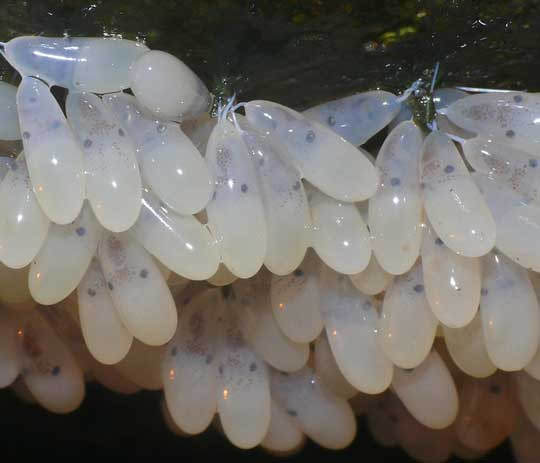
Amazingly, scientists aboard a research vessel in 2005 were able to observe a baby dumbo octopus hatch out of an egg in a dish. It was the first time such a thing had been witnessed and filmed.
Check out this video of the newly-hatched octopus!
Notice how huge the "ear fins" are when these creatures are this young.
And check out this video of an adult dumbo octopus.
One more fascinating tidbit. Dumbo octopuses have hairy arms. Well, they aren't really hairs. They are actually called cilia, and they protrude from the octopus's suckers. There are several theories for the purpose of these cilia. First, it is likely they are used in feeding. When the octopus is sitting on the ocean floor, these cilia produce a slight but steady current of water in the direction of the octopus. It is thought that this can lure prey closer.
Also, the cilia act kind of like whiskers. When the octopus feels the area around it, the cilia serve as tiny antennae to help find prey.
And finally, the octopus uses the cilia to aerate the water around itself, both for its own benefit and to provide more oxygen for its eggs. The cilia produce a current, which pulls oxygen-rich water in from its surroundings to replace the water from which it has already depleted the oxygen.
You can see the cilia in the photo below.
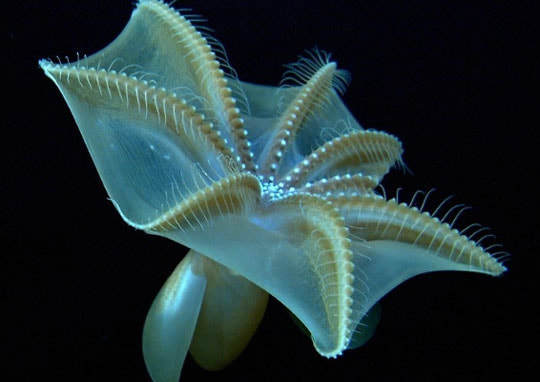
So, the dumbo octopus deserves a place in the. E.A.H.O.F.
(Exquisite Animal Hall of Fame).
FUN FACT: The word Exquisite has had several meanings over the centuries. It originally came from exquisitus, a Latin word meaning "choice" or "chosen with care." When it was first used in English, it meant "anything brought to a highly-wrought condition." This included bad things (such as torture) as well as good things (such as art). Finally, in about 1580, it took on its modern meaning, which is "of consummate and delightful excellence." So, exquisite is another way to say awesome!
Photo Credits:
Praying mantis in threat posture - Wikimedia via Sunoven
Dumbo octopus #1: MBARI via Ocean Conservancy
Dumbo octopus #2, swimming - Oceana.org
Dumbo octopus capturing fish - Ocean Exploration Trust via NautilusLive
Dumbo octopus eggs - Albers
Dumbo octopus showing cilia - Octolab.tv
And... did you know octopuses are mollusks? Yep, they are in the same animal phylum as snails, slugs, clams, oysters, and squid (as well as many others). I know... they don't look anything like a snail or a clam, right?
AND... did you know there are about 300 species of octopuses? And if there is one type that deserves to have squishy toys made in its image—it has to be the dumbo octopus.

What the heck is a Dumbo Octopus?
Dumbo octopuses include about 13 species of umbrella octopuses (a group that kind of look like an umbrella when they spread their tentacles). The name dumbo comes from the fact that they have two fins that spread out above the eyes, resembling the oversized ears of Dumbo the elephant (from the 1941 animated Disney film). Actually, very little is known about the dumbo octopus, but we know enough to be confident that they are awesome! Let's take a look.
Amazing facts about the Dumbo Octopus
You're not going to see a dumbo octopus while you're out snorkeling in shallow water. Why? Because these octopuses live deep in the ocean. Most of them live at depths of about 13,000 feet (4,000 m), and some have been found as deep as 23,000 feet (7,000 m). That's over four miles down! Chances are, they live even deeper than that. This makes them by far the deepest living of all the octopuses.
Dumbo octopuses appear to move through the water by slowly flapping their ear-like fins, but actually they are gently squirting water from their tentacle-funnel, and their ear fins are providing stability and steering. They can also crawl along the sea floor with their tentacles (you can call them arms if you want, but I just like to say the word tentacles). Since these methods of movement are slow, to escape from predators they also can dart away by aggressively squeezing water out. They do this by expanding and contracting their tentacles, making use of the funnel-like webbing between their tentacles.

Dumbo octopuses are fairly small, averaging about 8 to 12 inches (20-30 cm) long, about the size of a guinea pig. But larger ones have been found. The largest of these was 5 feet 10 inches (1.8 m) long and weighed 13 pounds (5.9 kg). I guess you could call that one a jumbo dumbo octopus.
Since dumbo octopuses live so deep, they are not threatened much by human activity. But they do have to worry about sharks and predatory cephalopods (such as larger octopuses and squid).
Dumbo octopuses are quite rare and difficult to find, so we don't know much about their population size, and we really don't know if they are threatened or if they simply are naturally scarce.
Dumbo octopuses may look cute and cuddly, but they are efficient and deadly predators. They typically float around in the open water, gently flapping their "dumbo ears" (fins), and when they find a fish or other prey, they pounce on it quickly and swallow it in one gulp. Their most common prey animals include worms, various crustaceans, copepods, amphipods, and isopods (that's a lot of pods). Below is a dumbo octopus catching a fish.

These creatures have a rather unusual sex life. First of all, there is no distinct season for breeding. Why? Because, this deep in the ocean, seasons don't have any significance. Not only that, but food is often scarce. And the ocean is a huge place! So these octopuses rarely encounter each other. So when a male does occasionally encounter a female, he uses a special protuberance on one of his arms to deliver a sperm packet into the female's mantle. The female then stores the sperm in her body and uses it when she happens to detect that her environment is favorable for laying eggs (kind of like putting a cookie in your pocket and saving it for later when you might get hungry). And, amazingly, the females usually have numerous eggs stored, and these eggs are at different stages of development, so that the female is ready with mature eggs whenever conditions happen to be right to fertilize the eggs and lay them (it's time to get that cookie out and munch on it).
The female typically lays her eggs attached to the bottoms of rocks on the ocean floor. In the photo below you can see the eyes of the developing embryos within the eggs.

Amazingly, scientists aboard a research vessel in 2005 were able to observe a baby dumbo octopus hatch out of an egg in a dish. It was the first time such a thing had been witnessed and filmed.
Check out this video of the newly-hatched octopus!
Notice how huge the "ear fins" are when these creatures are this young.
And check out this video of an adult dumbo octopus.
One more fascinating tidbit. Dumbo octopuses have hairy arms. Well, they aren't really hairs. They are actually called cilia, and they protrude from the octopus's suckers. There are several theories for the purpose of these cilia. First, it is likely they are used in feeding. When the octopus is sitting on the ocean floor, these cilia produce a slight but steady current of water in the direction of the octopus. It is thought that this can lure prey closer.
Also, the cilia act kind of like whiskers. When the octopus feels the area around it, the cilia serve as tiny antennae to help find prey.
And finally, the octopus uses the cilia to aerate the water around itself, both for its own benefit and to provide more oxygen for its eggs. The cilia produce a current, which pulls oxygen-rich water in from its surroundings to replace the water from which it has already depleted the oxygen.
You can see the cilia in the photo below.

So, the dumbo octopus deserves a place in the. E.A.H.O.F.
(Exquisite Animal Hall of Fame).
FUN FACT: The word Exquisite has had several meanings over the centuries. It originally came from exquisitus, a Latin word meaning "choice" or "chosen with care." When it was first used in English, it meant "anything brought to a highly-wrought condition." This included bad things (such as torture) as well as good things (such as art). Finally, in about 1580, it took on its modern meaning, which is "of consummate and delightful excellence." So, exquisite is another way to say awesome!
Photo Credits:
Praying mantis in threat posture - Wikimedia via Sunoven
Dumbo octopus #1: MBARI via Ocean Conservancy
Dumbo octopus #2, swimming - Oceana.org
Dumbo octopus capturing fish - Ocean Exploration Trust via NautilusLive
Dumbo octopus eggs - Albers
Dumbo octopus showing cilia - Octolab.tv
Published on October 03, 2019 10:30
September 17, 2019
Awesome Animal - Salp
It's possible that this may be the strangest animal I've featured so far. Recently I came upon an article about these creatures, which have been given various names such as 'aliens', 'globs', 'jelly balls', 'buckets of snot', and 'sea walnuts'. With such great collection of names, this creature is worth a closer look.
What the heck is a Salp?
Basically, the salp is a barrel-shaped tunicate. What is a tunicate, you ask? Tunicates (subphylum Tunicata) are invertebrate animals that are in the Chordata phylum (this means they have a dorsal nerve cord, which includes all vertebrate animals, including humans). Tunicates, including salps, live in salt water, and they are filter feeders (they filter tiny plankton from the water). They have sac-like bodies, with one opening that takes in water and one opening that expels the water.
As adults, most tunicate are permanently attached to rocks or coral. But not salps—these amazing jet-powered creatures prefer to swim around freely, either by themselves or in really cool long, stringy colonies.
Are you confused about this explanation? Well, then let's dig into this more carefully. First, here's what an individual salp looks like:

Amazing facts about the Salp
First, I think it will help to understand what we are looking at in the photo above. The "head" is at the larger end at the left. This is where the mouth is, which pulls in water. This water is extremely important to the critter, because it provides food, oxygen, and propulsion. Notice the vertical striations along the side? Those are bands of muscles. When those muscles contract, water shoots out the tail end (the narrow end at the right), which is the most impressive jet propulsion system in the animal kingdom. But before the water is expelled, the salp absorbs oxygen and filters out the particles of food. The tan-colored object near the tail end is the stomach and intestine (the gut).
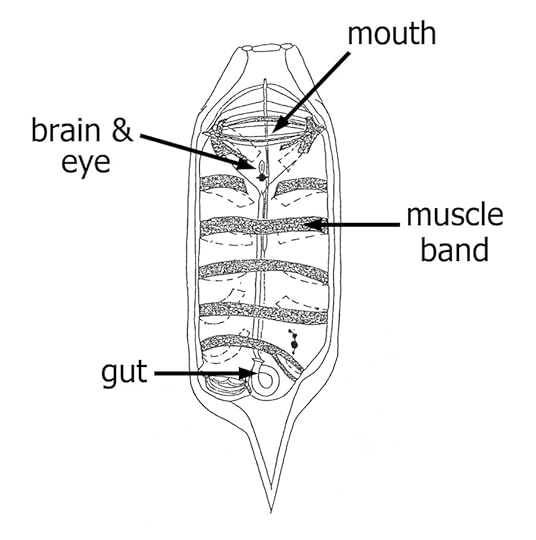
Okay, now that we have that crazy body figured out, let's take a look at the salp's even crazier life cycle. These creatures have what's called alternation of generations. This means that the generations switch back and forth between two forms. One form is the free-swimming, barrel-shaped individual (as seen above). The weird thing is, though, that these individuals do not produce more individuals! Instead, they reproduce asexually by producing a connected chain of tens to hundreds of all-female salps. This chain starts out very small, and then as the individuals in the chain grow, the chain can become quite large (sometimes longer than a bus!).

So, the free-swimming individuals asexually produce the next generation, which is a connected chain of female salps. By the way, asexual reproduction is the process of producing offspring without mating (without combining the DNA of a male and a female), and so all the offspring in asexual reproduction are genetically identical (clones) of the parent.
Amazingly, this long chain swims around in the open water using the same jet-propulsion method as the individuals, except that it is done in a coordinated manner.
Below is a salp "giving birth" to such a chain:
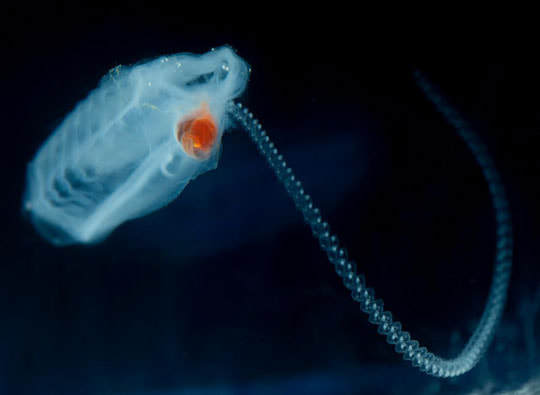
Okay, so how do the individuals in the chain reproduce to make the next generation? This is where things get really weird. These connected individuals are what we call hermaphrodites—they have sexual organs of both sexes (although in this case not at the same time) and can produce both eggs and sperm. The individuals in the chain first mature as females, and they are fertilized by the males of an older chain that they encounter as the chain swims around in the ocean. The resulting embryo grows in the body wall of each chain individual and is then released into the water to live its life as a free-swimming salp (this completes the alternating cycle of generations). AND... then the females in the chain turn into males, and they fertilize the females of a younger chain!
Wow. Geez! Whew! This reproduction craziness makes my head spin. Okay, I have to ask this, because I guess it's the way my mind works: What would it be like if humans had this same kind of life history cycle? Free-walking individuals, which produce chains of hundreds of connected babies, which mature as females and are fertilized by chains of males, and then the chains of females turn into males and fertilize chains of females, which produce free-walking individuals.
Thanks a lot, Stan. That's an image I can never erase from my visual cortex!
Moving on...
Salps are jelly-like in appearance, but they are NOT jellyfish—not even close. The only thing they have in common with Jellyfish is that they both float around in the water. Jellyfish are in the phylum Cnidaria, and they very simple animals. Jellyfish are similar to corals, whereas salps are more similar to humans. Salps have complex nervous systems and digestive systems, with a brain, heart, and intestines. Salps diverged (evolutionarily) from jellyfish 800 million years ago! Salps, like humans, are Chordates. Obviously, they are distantly related to humans, but they are much more distantly related to jellyfish.
Check out this spiral salp chain.
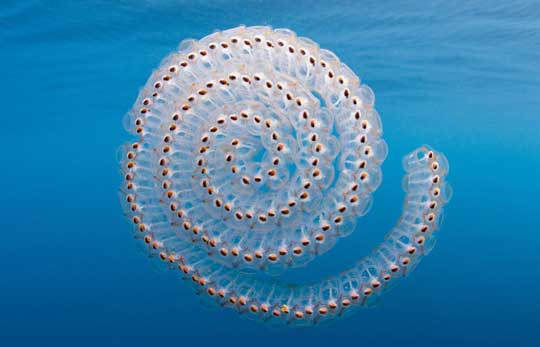
Salps are important to the global ecosystem. Why? Salps feed on plankton, such as floating, single-celled algae. These algae have absorbed a lot of dissolved carbon dioxide from the ocean. This means that carbon accumulates in the guts of salps. The salps excrete this as solid waste that sinks to the ocean floor. Also, when the salps die, their bodies sink to the ocean floor. This process effectively removes a lot of carbon from the carbon cycle. This removes carbon dioxide from the atmosphere, thus slowing down global warming. Cool, huh? (pun intended)
Not only that, but when there is a huge algae bloom, the salps respond by reproducing faster, becoming densely populated in the area of the algae bloom and slurp up the algae, removing even more carbon.
But even though these "salp blooms" are removing more algae and carbon, sometimes the salps themselves can become really abundant. According to scientists, as the average temperature on Earth warms up, the larger plankton (like diatoms) in the oceans is being replaced by smaller plankton (called picoplankton). And salps are very good at eating the smaller plankton. The result? Salps are becoming far more abundant than they previously were.
This results in dead salps sometimes washing up onto beaches, creating a thick layer of jelly-like bodies. But don't worry... they are not harmful to the environment, and unlike jellyfish, these gentle creatures do not sting.
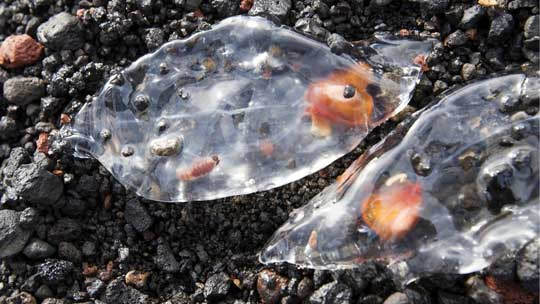
So, the salp deserves a place in the. H.D.A.H.O.F.
(Hunky Dory Animal Hall of Fame).
FUN FACT: Hunky dory is an American phrase that originated in about 1862. Its basic meaning is 'quite satisfactory', or 'fine' (as in "I got a good night's sleep, and I was all hunky dory in the morning"). Explaining its origin is a bit of a challenge, though. The phrase almost certainly came from the now-archaic slang word hunk, which meant 'safe', which in turn came from the Dutch word honk, meaning 'goal' or 'home' in a game. In a child's game, to make it home and win the game was to achieve hunk. Now, the dory part of it is uncertain, but it is likely that it is a result of the way children like to express things. Instead of saying O.K., children like to say okey-dokey. So it is thought that hunky dory originated in the same way—hunk is more fun to say that way! So, hunky dory is another way to say awesome (kind of)! Photo Credits:
Salp in hand - Southern Fried Science
Salp diagram - The Biology of Pelagic Tunicates (Bone 1998) via bodegahead blog post
Salp chain and diver - Wikimedia Commons
Salp producing chain of offspring - Mike Stukel via NIWA
Spiral chain of salps - CGTN
Salp on the beach - CGTN
What the heck is a Salp?
Basically, the salp is a barrel-shaped tunicate. What is a tunicate, you ask? Tunicates (subphylum Tunicata) are invertebrate animals that are in the Chordata phylum (this means they have a dorsal nerve cord, which includes all vertebrate animals, including humans). Tunicates, including salps, live in salt water, and they are filter feeders (they filter tiny plankton from the water). They have sac-like bodies, with one opening that takes in water and one opening that expels the water.
As adults, most tunicate are permanently attached to rocks or coral. But not salps—these amazing jet-powered creatures prefer to swim around freely, either by themselves or in really cool long, stringy colonies.
Are you confused about this explanation? Well, then let's dig into this more carefully. First, here's what an individual salp looks like:

Amazing facts about the Salp
First, I think it will help to understand what we are looking at in the photo above. The "head" is at the larger end at the left. This is where the mouth is, which pulls in water. This water is extremely important to the critter, because it provides food, oxygen, and propulsion. Notice the vertical striations along the side? Those are bands of muscles. When those muscles contract, water shoots out the tail end (the narrow end at the right), which is the most impressive jet propulsion system in the animal kingdom. But before the water is expelled, the salp absorbs oxygen and filters out the particles of food. The tan-colored object near the tail end is the stomach and intestine (the gut).

Okay, now that we have that crazy body figured out, let's take a look at the salp's even crazier life cycle. These creatures have what's called alternation of generations. This means that the generations switch back and forth between two forms. One form is the free-swimming, barrel-shaped individual (as seen above). The weird thing is, though, that these individuals do not produce more individuals! Instead, they reproduce asexually by producing a connected chain of tens to hundreds of all-female salps. This chain starts out very small, and then as the individuals in the chain grow, the chain can become quite large (sometimes longer than a bus!).

So, the free-swimming individuals asexually produce the next generation, which is a connected chain of female salps. By the way, asexual reproduction is the process of producing offspring without mating (without combining the DNA of a male and a female), and so all the offspring in asexual reproduction are genetically identical (clones) of the parent.
Amazingly, this long chain swims around in the open water using the same jet-propulsion method as the individuals, except that it is done in a coordinated manner.
Below is a salp "giving birth" to such a chain:

Okay, so how do the individuals in the chain reproduce to make the next generation? This is where things get really weird. These connected individuals are what we call hermaphrodites—they have sexual organs of both sexes (although in this case not at the same time) and can produce both eggs and sperm. The individuals in the chain first mature as females, and they are fertilized by the males of an older chain that they encounter as the chain swims around in the ocean. The resulting embryo grows in the body wall of each chain individual and is then released into the water to live its life as a free-swimming salp (this completes the alternating cycle of generations). AND... then the females in the chain turn into males, and they fertilize the females of a younger chain!
Wow. Geez! Whew! This reproduction craziness makes my head spin. Okay, I have to ask this, because I guess it's the way my mind works: What would it be like if humans had this same kind of life history cycle? Free-walking individuals, which produce chains of hundreds of connected babies, which mature as females and are fertilized by chains of males, and then the chains of females turn into males and fertilize chains of females, which produce free-walking individuals.
Thanks a lot, Stan. That's an image I can never erase from my visual cortex!
Moving on...
Salps are jelly-like in appearance, but they are NOT jellyfish—not even close. The only thing they have in common with Jellyfish is that they both float around in the water. Jellyfish are in the phylum Cnidaria, and they very simple animals. Jellyfish are similar to corals, whereas salps are more similar to humans. Salps have complex nervous systems and digestive systems, with a brain, heart, and intestines. Salps diverged (evolutionarily) from jellyfish 800 million years ago! Salps, like humans, are Chordates. Obviously, they are distantly related to humans, but they are much more distantly related to jellyfish.
Check out this spiral salp chain.

Salps are important to the global ecosystem. Why? Salps feed on plankton, such as floating, single-celled algae. These algae have absorbed a lot of dissolved carbon dioxide from the ocean. This means that carbon accumulates in the guts of salps. The salps excrete this as solid waste that sinks to the ocean floor. Also, when the salps die, their bodies sink to the ocean floor. This process effectively removes a lot of carbon from the carbon cycle. This removes carbon dioxide from the atmosphere, thus slowing down global warming. Cool, huh? (pun intended)
Not only that, but when there is a huge algae bloom, the salps respond by reproducing faster, becoming densely populated in the area of the algae bloom and slurp up the algae, removing even more carbon.
But even though these "salp blooms" are removing more algae and carbon, sometimes the salps themselves can become really abundant. According to scientists, as the average temperature on Earth warms up, the larger plankton (like diatoms) in the oceans is being replaced by smaller plankton (called picoplankton). And salps are very good at eating the smaller plankton. The result? Salps are becoming far more abundant than they previously were.
This results in dead salps sometimes washing up onto beaches, creating a thick layer of jelly-like bodies. But don't worry... they are not harmful to the environment, and unlike jellyfish, these gentle creatures do not sting.

So, the salp deserves a place in the. H.D.A.H.O.F.
(Hunky Dory Animal Hall of Fame).
FUN FACT: Hunky dory is an American phrase that originated in about 1862. Its basic meaning is 'quite satisfactory', or 'fine' (as in "I got a good night's sleep, and I was all hunky dory in the morning"). Explaining its origin is a bit of a challenge, though. The phrase almost certainly came from the now-archaic slang word hunk, which meant 'safe', which in turn came from the Dutch word honk, meaning 'goal' or 'home' in a game. In a child's game, to make it home and win the game was to achieve hunk. Now, the dory part of it is uncertain, but it is likely that it is a result of the way children like to express things. Instead of saying O.K., children like to say okey-dokey. So it is thought that hunky dory originated in the same way—hunk is more fun to say that way! So, hunky dory is another way to say awesome (kind of)! Photo Credits:
Salp in hand - Southern Fried Science
Salp diagram - The Biology of Pelagic Tunicates (Bone 1998) via bodegahead blog post
Salp chain and diver - Wikimedia Commons
Salp producing chain of offspring - Mike Stukel via NIWA
Spiral chain of salps - CGTN
Salp on the beach - CGTN
Published on September 17, 2019 08:02
September 4, 2019
Awesome Animal - Snub-Nosed Monkey
I was thinking about this, and I realized I have never featured a monkey as an Awesome Animal! It's time to remedy that. And it might as well be an unusual one that few people have heard of.
What the heck is a Snub-Nosed Monkey?
Snub-nosed monkeys live in Asia, including southern China, Vietnam, and Myanmar. There are about four species, and they are the only members of the genus Rhinopithecus.
The name snub-nosed monkey comes from the fact that these creatures don't have much of a nose. The forward-facing nostrils are flat on the face. This is one of many adaptations for living in extremely cold habitats.
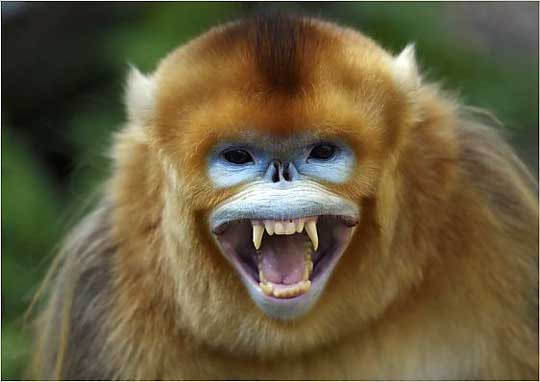
Amazing facts about the Snub-Nosed Monkey
Snub-nosed monkeys are one of the few types of monkeys that live in temperate areas (places with distinct seasons, including a cold winter). They typically live in the mountains. For example, the golden snub-nosed monkey will spend the summer months at altitudes of up to 13,000 feet (4,000 meters) in the mountains of Tibet. The snow cover can last six months in this area.
Snub-nosed monkeys have relatively long hair, which covers their entire body except around the eyes and mouth. Even their hands are fur-covered, making it look like they are wearing mittens. And the flat snub-nose itself is thought to be an adaptation to sub-freezing temperatures (animals that live in cold climates have fewer protruding body parts that can freeze... shorter ears, stubby noses, etc.).
Here is a golden snub-nosed monkey in its cold, mountainous habitat:

The photo above shows a snub-nosed monkey on the ground, but this is actually rare in the wild, as these monkeys spend 97% of their time in trees. They eat in trees, sleep in trees, and socialize in trees.
Speaking of socializing, these creatures are amazingly social. During the cold months of winter, they live in groups of about 30. But in the warmer months, they come together into troops of at least 200, and sometimes as many as 600! This seasonal forming and splitting of groups, called fission and fusion, is unusual among the other types of monkeys.
Snub-nosed monkeys are ventriloquists. They can emit a wide range of calls without any visible movement of their mouths. This is mostly because of their unusually large nostrils. They are also extremely talented vocalists. They can produce 18 different types of calls, including calls that express affection or aggression, warning of danger, and contact calls specifically used when groups are joining together into larger troops.
These monkeys also have a tendency to call in a chorus, in which numerous individuals call at the same time for several seconds.
Check out this video that shows socialization behaviors.
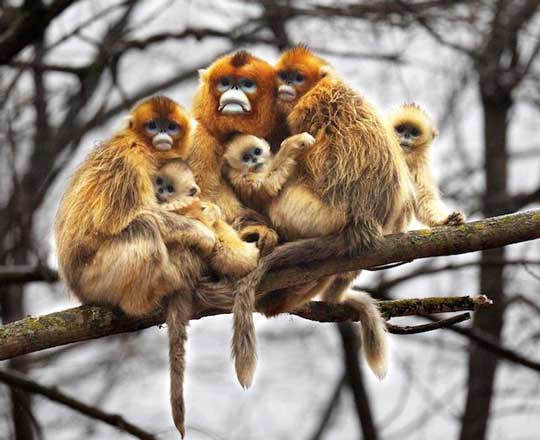
The golden snub-nosed monkey has the scientific name Rhinopithecus roxellana. The roxellana portion of the name comes from Roxelana, the concubine and wife of Süleyman the Magnificent, a 16th century Sultan of the Ottoman Empire. supposedly, Roxelana had reddish-gold hair and a snub nose. I wonder how she would have felt about having a monkey named after her?
Snub-nosed monkeys are rather slow in their growth and reproduction. One dominant male will mate with numerous females, and then the gestation period is seven months. Females give birth to only one baby, and the young aren't weaned until a year later. The male young aren't ready to mate for seven years, whereas the females are ready in four to five years.
Check out this baby golden snub-nosed monkey (they are gray as youngsters), a good candidate for the "cutest baby animal ever" award:

Wait... most monkeys live in tropical areas and eat fruits and leaves (and sometimes insects). If snub-nosed monkeys live in the cold mountains, what the heck do they eat? Well, during the warmer months they are are able to eat pine needles and broadleaf leaves, as well as wild onions, grasses, flower buds, and some insects. When winter comes they feed on lichens and tree bark. Yummy... lichens and tree bark!
And don't forget that there are at least four different species of snub-nosed monkeys (some scientists think there are five). The most commonly known is the golden snub-nosed monkey (several photos above). Unfortunately, for a long time it was thought that the fur of the golden snub-nosed monkey had medicinal qualities, in particular that it could prevent and cure rheumatism. And so government officials and other wealthy people would wear coats and hats made from the fur. As you can probably guess, this species has been almost decimated by hunting (which is no longer allowed). The population has also been harmed by harvesting the dead trees that provide them with most of the lichens they need to eat.
And there is the black and white snub-nosed monkey, also known as the Yunnan snub-nosed monkey (pictured below). This species lives only in the southern China province of Yunnan. They live at the highest altitude of any other nonhuman primate... as high as 15,400 feet (4,700 meters). Brrr... very cold up there.
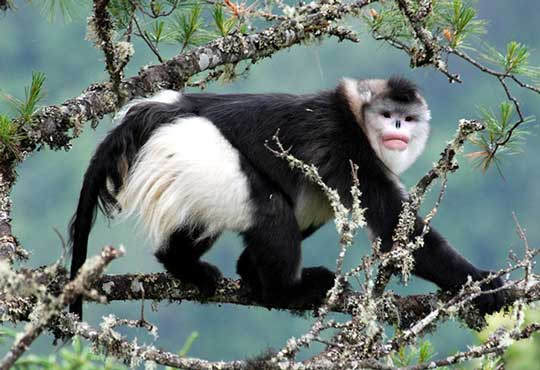
And then we have the gray snub-nosed monkey, which is highly endangered, with a population of less than 750. They currently live only in Mount Fanjing National Nature Reserve in the Wuling Mountains in China. See below.

And then we have the gray snub-nosed monkey, which is highly endangered, with a population of less than 750. They currently live only in Mount Fanjing National Nature Reserve in the Wuling Mountains in China. See below.

You have to admit, these monkeys are pretty darn awesome, right?
So, the snub-nosed monkey deserves a place in the B.K.A.H.O.F.
(Bee's Knees Animal Hall of Fame).
FUN FACT: Okay, this one's a bit of a stretch because the phrase the bee's knees is usually used as a noun, as in "Snub-nosed monkeys? Oh, they're the bee's knees." This phrase's meaning has changed a lot over the years. It was first recorded in the late 1700s, and at that time it was used to describe something very small and insignificant. And then at some point it became a nonsense expression, to describe something that didn't have any meaningful existence. Then during the jazz scene in America in the 1920s, people started to use it to mean excellent, along with other similar phrases such as "the cat's meow" and "the flea's eyebrows." So, if you are willing to use it as an adjective, the bee's knees is another way to say awesome!
Photo Credits:
Golden snub-nosed monkey #1 - Nature Picture Library
Golden snub-nosed monkey in mountains - Animal Spot
Group of golden snub-nosed monkeys - Wang LiQiang via Zoo Portraits
Baby golden snub-nosed monkey - Animal Spot
Black (Yunnan) snub-nosed monkey - Earth.com
Gray Snub-nosed monkeys - Ming Li via Phys.org
What the heck is a Snub-Nosed Monkey?
Snub-nosed monkeys live in Asia, including southern China, Vietnam, and Myanmar. There are about four species, and they are the only members of the genus Rhinopithecus.
The name snub-nosed monkey comes from the fact that these creatures don't have much of a nose. The forward-facing nostrils are flat on the face. This is one of many adaptations for living in extremely cold habitats.

Amazing facts about the Snub-Nosed Monkey
Snub-nosed monkeys are one of the few types of monkeys that live in temperate areas (places with distinct seasons, including a cold winter). They typically live in the mountains. For example, the golden snub-nosed monkey will spend the summer months at altitudes of up to 13,000 feet (4,000 meters) in the mountains of Tibet. The snow cover can last six months in this area.
Snub-nosed monkeys have relatively long hair, which covers their entire body except around the eyes and mouth. Even their hands are fur-covered, making it look like they are wearing mittens. And the flat snub-nose itself is thought to be an adaptation to sub-freezing temperatures (animals that live in cold climates have fewer protruding body parts that can freeze... shorter ears, stubby noses, etc.).
Here is a golden snub-nosed monkey in its cold, mountainous habitat:

The photo above shows a snub-nosed monkey on the ground, but this is actually rare in the wild, as these monkeys spend 97% of their time in trees. They eat in trees, sleep in trees, and socialize in trees.
Speaking of socializing, these creatures are amazingly social. During the cold months of winter, they live in groups of about 30. But in the warmer months, they come together into troops of at least 200, and sometimes as many as 600! This seasonal forming and splitting of groups, called fission and fusion, is unusual among the other types of monkeys.
Snub-nosed monkeys are ventriloquists. They can emit a wide range of calls without any visible movement of their mouths. This is mostly because of their unusually large nostrils. They are also extremely talented vocalists. They can produce 18 different types of calls, including calls that express affection or aggression, warning of danger, and contact calls specifically used when groups are joining together into larger troops.
These monkeys also have a tendency to call in a chorus, in which numerous individuals call at the same time for several seconds.
Check out this video that shows socialization behaviors.

The golden snub-nosed monkey has the scientific name Rhinopithecus roxellana. The roxellana portion of the name comes from Roxelana, the concubine and wife of Süleyman the Magnificent, a 16th century Sultan of the Ottoman Empire. supposedly, Roxelana had reddish-gold hair and a snub nose. I wonder how she would have felt about having a monkey named after her?
Snub-nosed monkeys are rather slow in their growth and reproduction. One dominant male will mate with numerous females, and then the gestation period is seven months. Females give birth to only one baby, and the young aren't weaned until a year later. The male young aren't ready to mate for seven years, whereas the females are ready in four to five years.
Check out this baby golden snub-nosed monkey (they are gray as youngsters), a good candidate for the "cutest baby animal ever" award:

Wait... most monkeys live in tropical areas and eat fruits and leaves (and sometimes insects). If snub-nosed monkeys live in the cold mountains, what the heck do they eat? Well, during the warmer months they are are able to eat pine needles and broadleaf leaves, as well as wild onions, grasses, flower buds, and some insects. When winter comes they feed on lichens and tree bark. Yummy... lichens and tree bark!
And don't forget that there are at least four different species of snub-nosed monkeys (some scientists think there are five). The most commonly known is the golden snub-nosed monkey (several photos above). Unfortunately, for a long time it was thought that the fur of the golden snub-nosed monkey had medicinal qualities, in particular that it could prevent and cure rheumatism. And so government officials and other wealthy people would wear coats and hats made from the fur. As you can probably guess, this species has been almost decimated by hunting (which is no longer allowed). The population has also been harmed by harvesting the dead trees that provide them with most of the lichens they need to eat.
And there is the black and white snub-nosed monkey, also known as the Yunnan snub-nosed monkey (pictured below). This species lives only in the southern China province of Yunnan. They live at the highest altitude of any other nonhuman primate... as high as 15,400 feet (4,700 meters). Brrr... very cold up there.

And then we have the gray snub-nosed monkey, which is highly endangered, with a population of less than 750. They currently live only in Mount Fanjing National Nature Reserve in the Wuling Mountains in China. See below.

And then we have the gray snub-nosed monkey, which is highly endangered, with a population of less than 750. They currently live only in Mount Fanjing National Nature Reserve in the Wuling Mountains in China. See below.

You have to admit, these monkeys are pretty darn awesome, right?
So, the snub-nosed monkey deserves a place in the B.K.A.H.O.F.
(Bee's Knees Animal Hall of Fame).
FUN FACT: Okay, this one's a bit of a stretch because the phrase the bee's knees is usually used as a noun, as in "Snub-nosed monkeys? Oh, they're the bee's knees." This phrase's meaning has changed a lot over the years. It was first recorded in the late 1700s, and at that time it was used to describe something very small and insignificant. And then at some point it became a nonsense expression, to describe something that didn't have any meaningful existence. Then during the jazz scene in America in the 1920s, people started to use it to mean excellent, along with other similar phrases such as "the cat's meow" and "the flea's eyebrows." So, if you are willing to use it as an adjective, the bee's knees is another way to say awesome!
Photo Credits:
Golden snub-nosed monkey #1 - Nature Picture Library
Golden snub-nosed monkey in mountains - Animal Spot
Group of golden snub-nosed monkeys - Wang LiQiang via Zoo Portraits
Baby golden snub-nosed monkey - Animal Spot
Black (Yunnan) snub-nosed monkey - Earth.com
Gray Snub-nosed monkeys - Ming Li via Phys.org
Published on September 04, 2019 16:51
August 25, 2019
Awesome Animal - Aardwolf
Okay, I have to admit I chose this animal simply because I think it has a cool name:
aardwolf
. That, and the fact that few people know much about it. Then the more I looked into this unique creature, the more I realized it is truly awesome.
What the heck is an Aardwolf?
The name aardwolf is derived from Afrikaans and Dutch, and it literally means "earth wolf." There are two isolated populations that live in South Africa and East Africa. The aardwolf is in the same family with hyenas (Hyaenidae), but it split off from the hyenas long ago and is classified in a different subfamily (Protelinae).
At first glance, the aardwolf looks similar to a striped hyena, but aardwolves are unique among cat-like and dog-like carnivores because they do not prey on large animals or carrion. Instead, they feed on insects!

Amazing facts about the Aardwolf
Aardwolves are much smaller than hyenas. Hyenas typically weigh between 60 pounds and 190 pounds (86 kg to 27 kg), whereas aardwolves weigh only 15 to 30 pounds (6.8 to 13.6 kg). They are more the size of lap dogs or domestic cats (only slightly larger than foxes).
By the way, in the Hyaenidae family, there are three species of hyenas and one species of aardwolf. Aardwolves have five toes on their front feet and four toes on the their hind feet, whereas hyenas have four toes on all their feet. Also, surprisingly, hyenas and aardwolves are more closely related to felines (cats) than to dogs.
Okay, let's talk about this insectivorous lifestyle. Aardwolves eat insects almost exclusively. Especially termites. They will eat small mammals and birds only as a last resort. They are sometimes seen hunkered over the carcass of a large dead animal, but they are not eating the dead animal—they are eating the insects and insect larvae that are feeding on the carcass.
Ready to be impressed? Aardwolves love termites. They love them so much that they can eat 300,000 in one night! Check out the yummy-looking termites below. Don't you wish you could slurp up 300,000 of those tasty morsels every night?
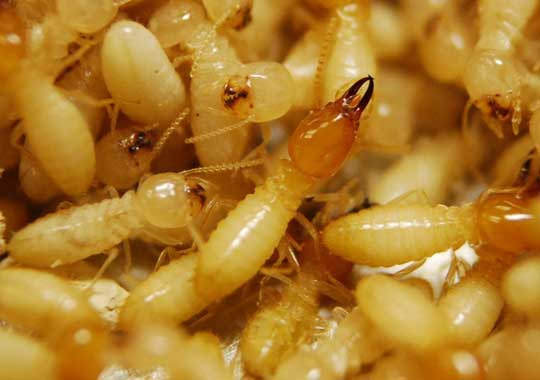
Just in case you don't fully appreciate the aardwolf's dedication to exclusively eating insects... when the weather turns cold and the termites and other insects become inactive, the aardwolf, instead of switching to other prey, will simply wait. They often lose up to 20% of their body mass because they choose to wait for those delicious bugs to become available again. Basically, they go on a hunger strike until they get what they want.
How do they eat so many termites? Well, the unrelated aardvark likes to tear into termite mounds and stick its long, sticky tongue down into the termite burrows. The aardwolf, on the other hand, takes a simpler approach. It doesn't tear up the termite mound at all. Instead, it simply licks the termites off the ground as they emerge from the nest.
Aardwolves hunt at night when termites are more likely to emerge from their nests. Aardwolves have excellent hearing and a keen sense of smell. Not only can they smell termites from a distance (a specific scent secreted by soldier termites), they can actually hear large groups of termites crawling in the grass. They simply walk up to them and lap them up with their sticky, bristly tongue.

Since aardwolves don't destroy the termite mounds, they can return to the mounds every few months to feed on them again. They have a knack for remembering the locations of the most productive mounds.
Aardwolves usually forage by themselves, for the simple reason that their unique food source is too scarce to allow them to forage in groups.
Check out this brief video about the aardwolf.
Like the hyenas, the aardwolf has a shaggy mane of hair along the ridge of its back. Since the aardwolf is not large, and since it is not a particularly fierce fighter, one way that it defends itself is to contract the tiny muscles that raise this glorious mane to full height. This is supposed to intimidate threatening predators such as lions and leopards. Hmm... a 20-pound critter with a mohawk. Doesn't seem that intimidating to me.

If the upright mane doesn't work, there's always Plan B. For an aardwolf, Plan B is to squirt out this nasty-smelling stuff from the anal glands—stuff that is almost as smelly as a skunk's spray. Now that's intimidating!
Aardwolves have an interesting social life. I've already mentioned that they go out at night and forage alone, due to necessity. But during the daylight hours they live in small family groups in burrows. Aardwolves' front legs are too weak to dig, so instead of digging their own burrows, they take up residence in the abandoned burrows of aardvarks. An added bonus of this is that aardvark burrows are almost always situated in areas with plenty of termite mounds (aardvarks eat termites too).
Aardwolves are blatant cheaters. Their family groups are considered monogamous... socially monogamous but not really sexually monogamous. Two parents live in a den with several offspring. The two parents often live together for their entire lives. But (and this is a big but), there is usually significant shenanigans going on in the dark of night. The adults frequently travel to other dens and engage in some hanky-panky. In fact, one study showed that 62% of copulations were not even between mated individuals. But in spite of this constant cheating, the pair usually continues to live together. Out of each litter of 2 to 4 babies, typically at least one is the live-in father's offspring.
Regardless of who the father is, baby aardwolves are pretty darn cute.

So, the aardwolf deserves a place in the N.A.H.O.F.
(Nonpareil Animal Hall of Fame).
FUN FACT: The word nonpareil was first used in the early 1400s and can be traced back to a Middle French origin. It was an adjective that literally meant "not equal." But since the late 1500s, it has commonly been used as a noun to describe an individual of unequaled excellence—he or she is one of a kind. In 1612, Captain John Smith used the word as a noun (with an archaic spelling): "Pocahontas, Powhatan's daughter... was the very Nomparell of his kingdome, and at most not past 13 or 14 years of age." Oddly, the word also means "a small pellet of colored sugar for decorating candy, cake, and cookies." And it is the name of a type of chocolate candy covered with bits of sugar. So, when used as an adjective, nonpareil is another way to say awesome!
Photo Credits:
Spiny orb-weaver spider - Wikipedia
Aardwolf #1` - https://www.britannica.com/animal/aardwolf/media/1/257/183802
Termites - Thomas Chouvenc via Entomology Today
Aardwolf tongue - Tambako The Jaguar via Flickr
Aardwolf mane - Pinterest
Baby Aardwolf - Reddit
What the heck is an Aardwolf?
The name aardwolf is derived from Afrikaans and Dutch, and it literally means "earth wolf." There are two isolated populations that live in South Africa and East Africa. The aardwolf is in the same family with hyenas (Hyaenidae), but it split off from the hyenas long ago and is classified in a different subfamily (Protelinae).
At first glance, the aardwolf looks similar to a striped hyena, but aardwolves are unique among cat-like and dog-like carnivores because they do not prey on large animals or carrion. Instead, they feed on insects!

Amazing facts about the Aardwolf
Aardwolves are much smaller than hyenas. Hyenas typically weigh between 60 pounds and 190 pounds (86 kg to 27 kg), whereas aardwolves weigh only 15 to 30 pounds (6.8 to 13.6 kg). They are more the size of lap dogs or domestic cats (only slightly larger than foxes).
By the way, in the Hyaenidae family, there are three species of hyenas and one species of aardwolf. Aardwolves have five toes on their front feet and four toes on the their hind feet, whereas hyenas have four toes on all their feet. Also, surprisingly, hyenas and aardwolves are more closely related to felines (cats) than to dogs.
Okay, let's talk about this insectivorous lifestyle. Aardwolves eat insects almost exclusively. Especially termites. They will eat small mammals and birds only as a last resort. They are sometimes seen hunkered over the carcass of a large dead animal, but they are not eating the dead animal—they are eating the insects and insect larvae that are feeding on the carcass.
Ready to be impressed? Aardwolves love termites. They love them so much that they can eat 300,000 in one night! Check out the yummy-looking termites below. Don't you wish you could slurp up 300,000 of those tasty morsels every night?

Just in case you don't fully appreciate the aardwolf's dedication to exclusively eating insects... when the weather turns cold and the termites and other insects become inactive, the aardwolf, instead of switching to other prey, will simply wait. They often lose up to 20% of their body mass because they choose to wait for those delicious bugs to become available again. Basically, they go on a hunger strike until they get what they want.
How do they eat so many termites? Well, the unrelated aardvark likes to tear into termite mounds and stick its long, sticky tongue down into the termite burrows. The aardwolf, on the other hand, takes a simpler approach. It doesn't tear up the termite mound at all. Instead, it simply licks the termites off the ground as they emerge from the nest.
Aardwolves hunt at night when termites are more likely to emerge from their nests. Aardwolves have excellent hearing and a keen sense of smell. Not only can they smell termites from a distance (a specific scent secreted by soldier termites), they can actually hear large groups of termites crawling in the grass. They simply walk up to them and lap them up with their sticky, bristly tongue.

Since aardwolves don't destroy the termite mounds, they can return to the mounds every few months to feed on them again. They have a knack for remembering the locations of the most productive mounds.
Aardwolves usually forage by themselves, for the simple reason that their unique food source is too scarce to allow them to forage in groups.
Check out this brief video about the aardwolf.
Like the hyenas, the aardwolf has a shaggy mane of hair along the ridge of its back. Since the aardwolf is not large, and since it is not a particularly fierce fighter, one way that it defends itself is to contract the tiny muscles that raise this glorious mane to full height. This is supposed to intimidate threatening predators such as lions and leopards. Hmm... a 20-pound critter with a mohawk. Doesn't seem that intimidating to me.

If the upright mane doesn't work, there's always Plan B. For an aardwolf, Plan B is to squirt out this nasty-smelling stuff from the anal glands—stuff that is almost as smelly as a skunk's spray. Now that's intimidating!
Aardwolves have an interesting social life. I've already mentioned that they go out at night and forage alone, due to necessity. But during the daylight hours they live in small family groups in burrows. Aardwolves' front legs are too weak to dig, so instead of digging their own burrows, they take up residence in the abandoned burrows of aardvarks. An added bonus of this is that aardvark burrows are almost always situated in areas with plenty of termite mounds (aardvarks eat termites too).
Aardwolves are blatant cheaters. Their family groups are considered monogamous... socially monogamous but not really sexually monogamous. Two parents live in a den with several offspring. The two parents often live together for their entire lives. But (and this is a big but), there is usually significant shenanigans going on in the dark of night. The adults frequently travel to other dens and engage in some hanky-panky. In fact, one study showed that 62% of copulations were not even between mated individuals. But in spite of this constant cheating, the pair usually continues to live together. Out of each litter of 2 to 4 babies, typically at least one is the live-in father's offspring.
Regardless of who the father is, baby aardwolves are pretty darn cute.

So, the aardwolf deserves a place in the N.A.H.O.F.
(Nonpareil Animal Hall of Fame).
FUN FACT: The word nonpareil was first used in the early 1400s and can be traced back to a Middle French origin. It was an adjective that literally meant "not equal." But since the late 1500s, it has commonly been used as a noun to describe an individual of unequaled excellence—he or she is one of a kind. In 1612, Captain John Smith used the word as a noun (with an archaic spelling): "Pocahontas, Powhatan's daughter... was the very Nomparell of his kingdome, and at most not past 13 or 14 years of age." Oddly, the word also means "a small pellet of colored sugar for decorating candy, cake, and cookies." And it is the name of a type of chocolate candy covered with bits of sugar. So, when used as an adjective, nonpareil is another way to say awesome!
Photo Credits:
Spiny orb-weaver spider - Wikipedia
Aardwolf #1` - https://www.britannica.com/animal/aardwolf/media/1/257/183802
Termites - Thomas Chouvenc via Entomology Today
Aardwolf tongue - Tambako The Jaguar via Flickr
Aardwolf mane - Pinterest
Baby Aardwolf - Reddit
Published on August 25, 2019 05:14



